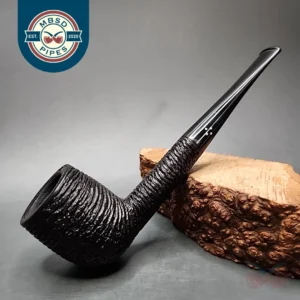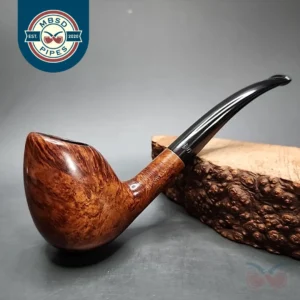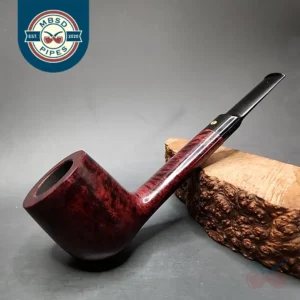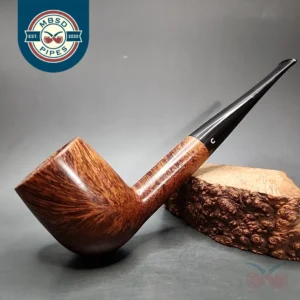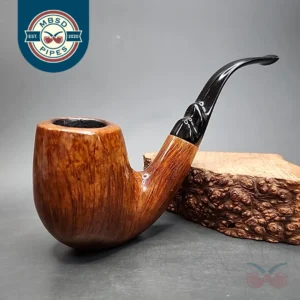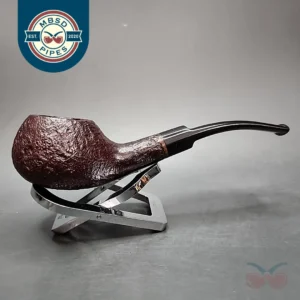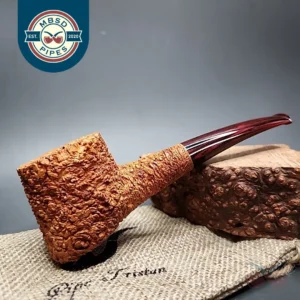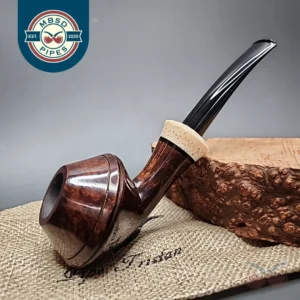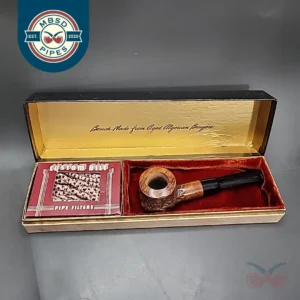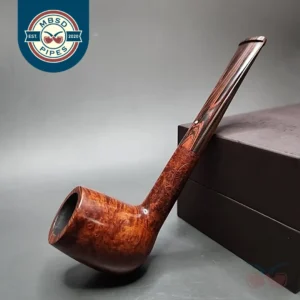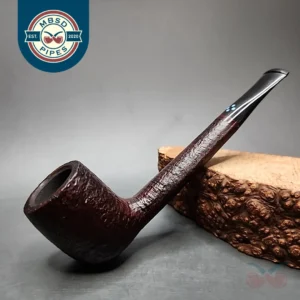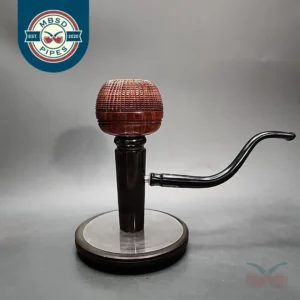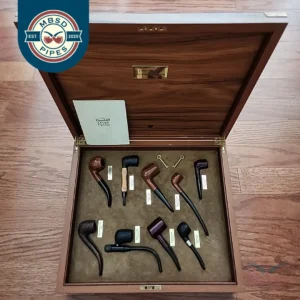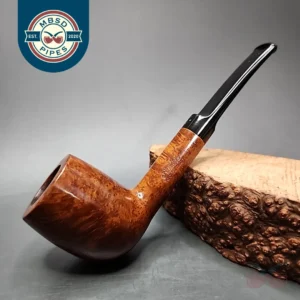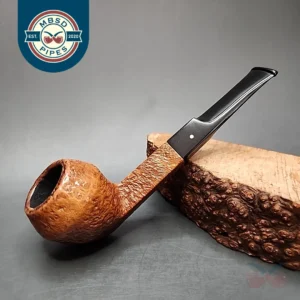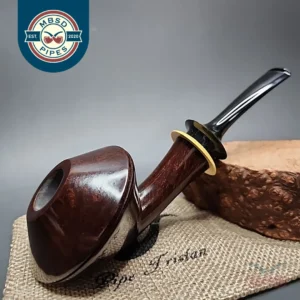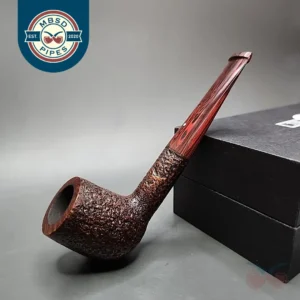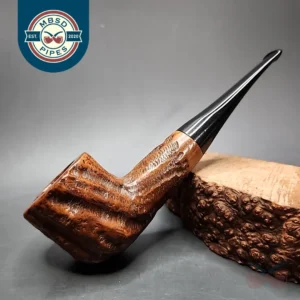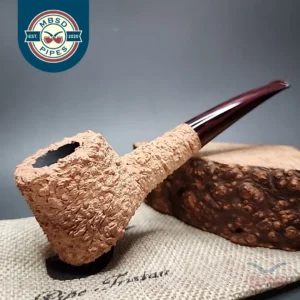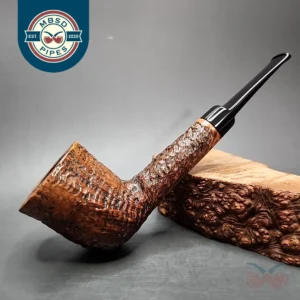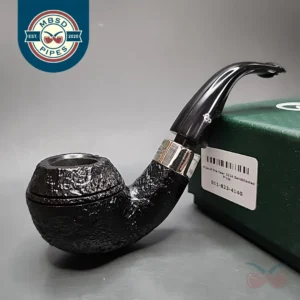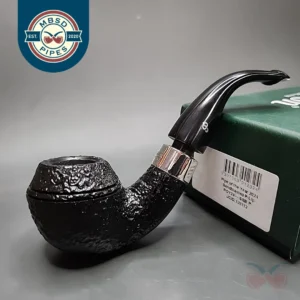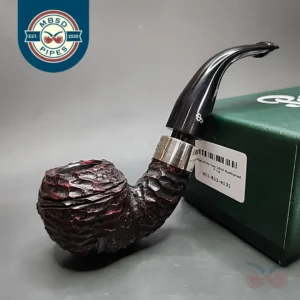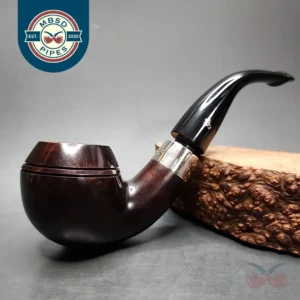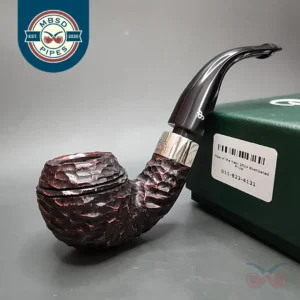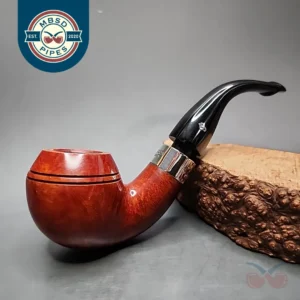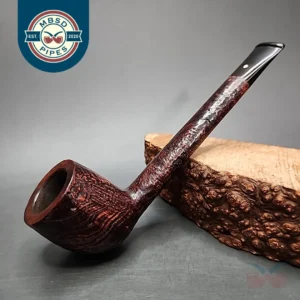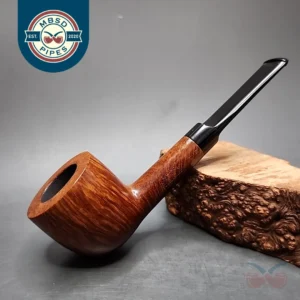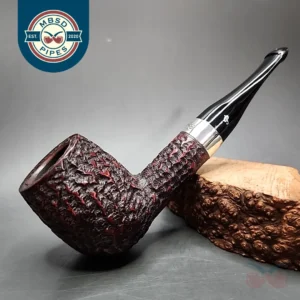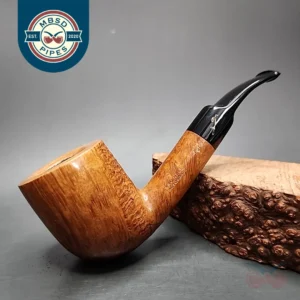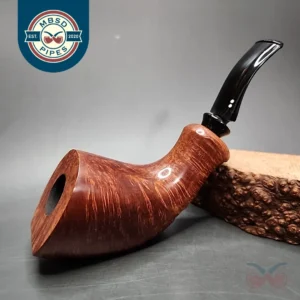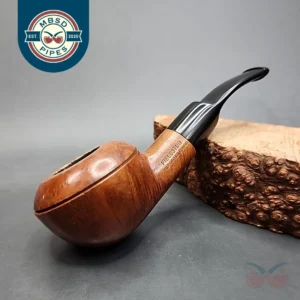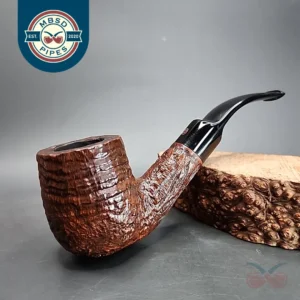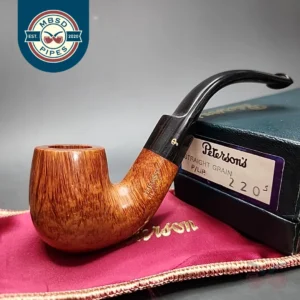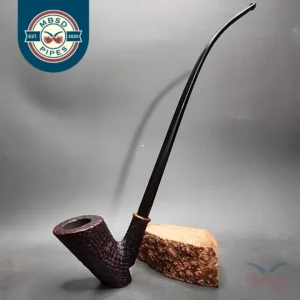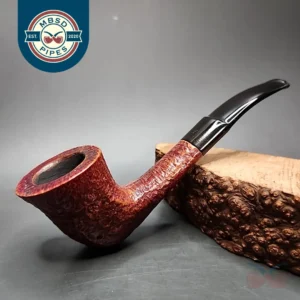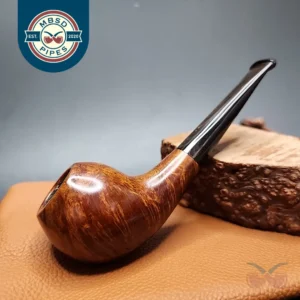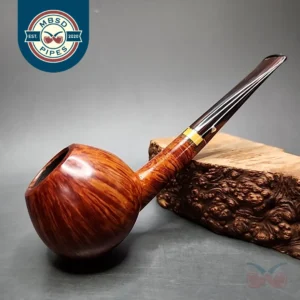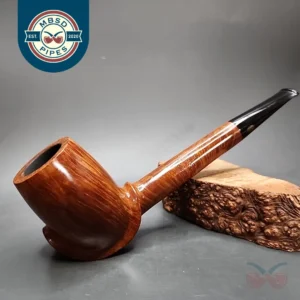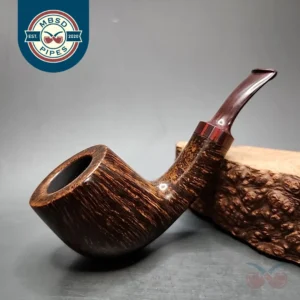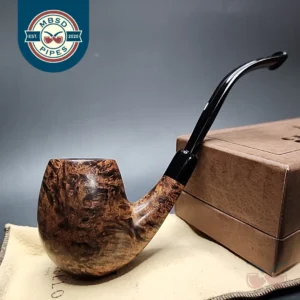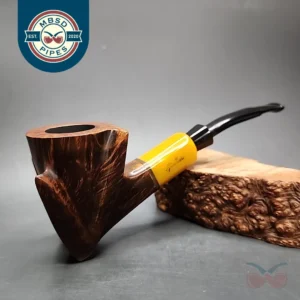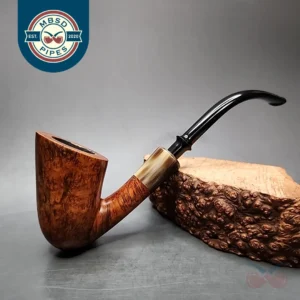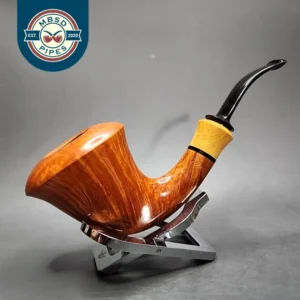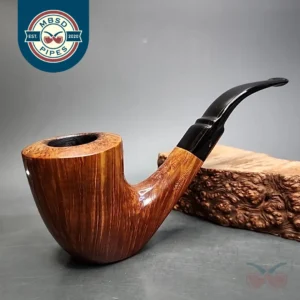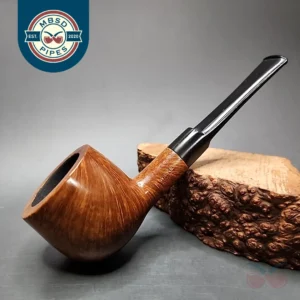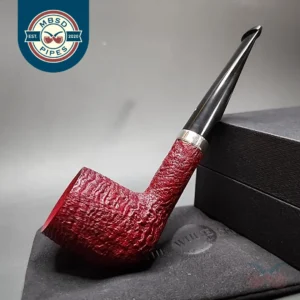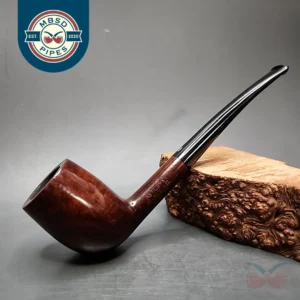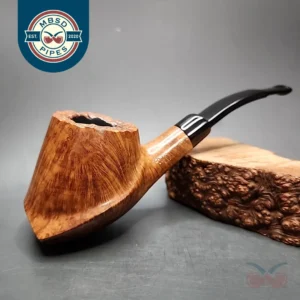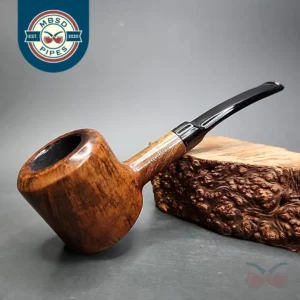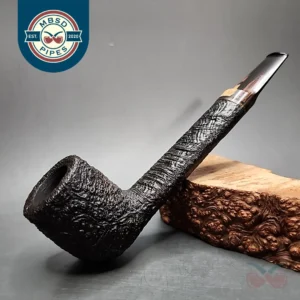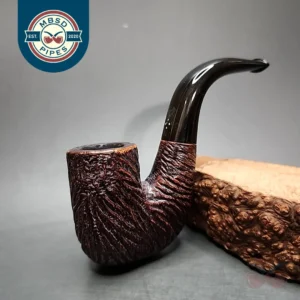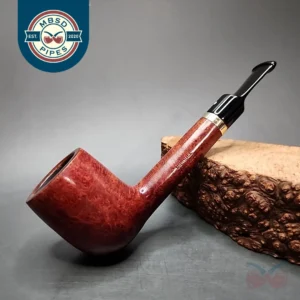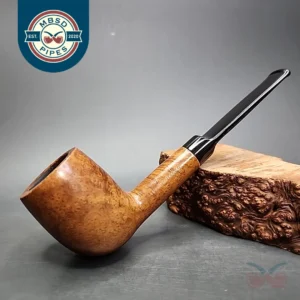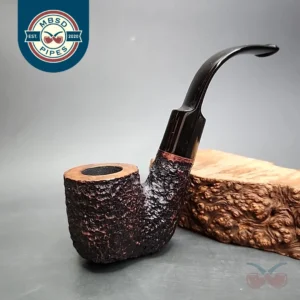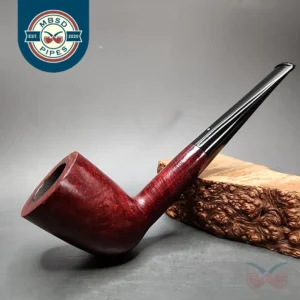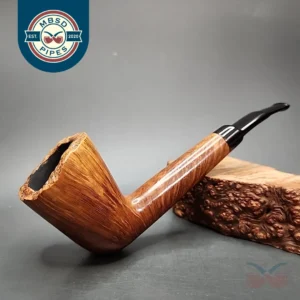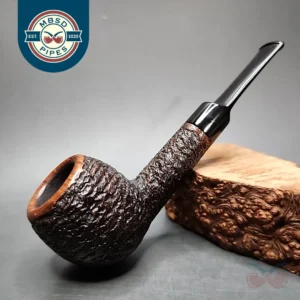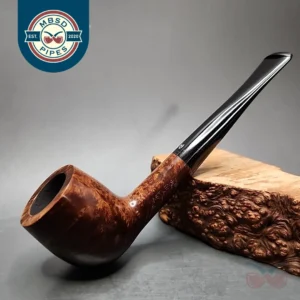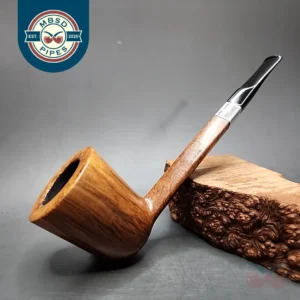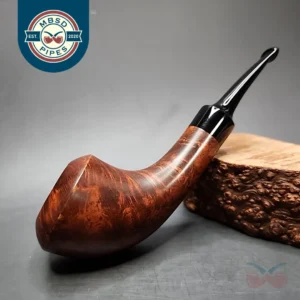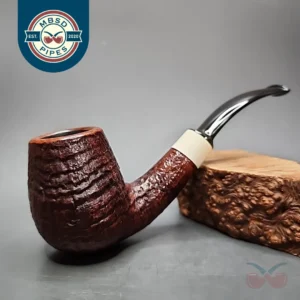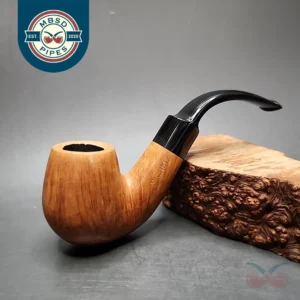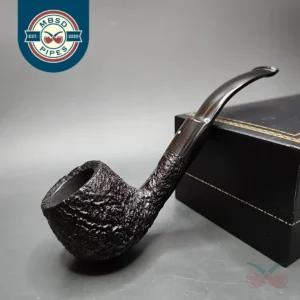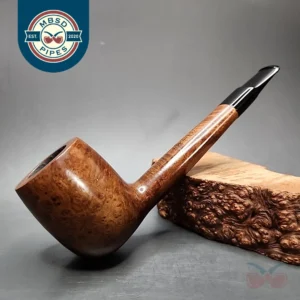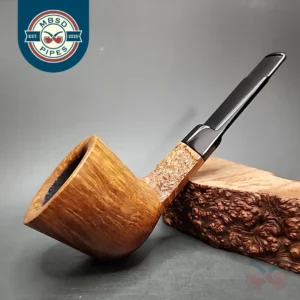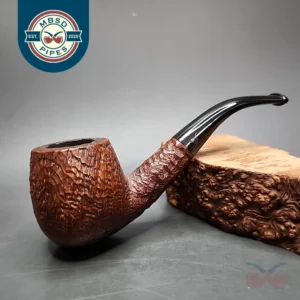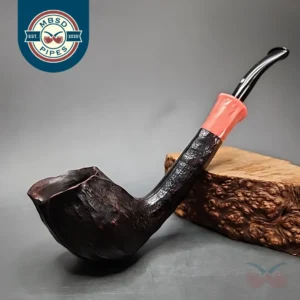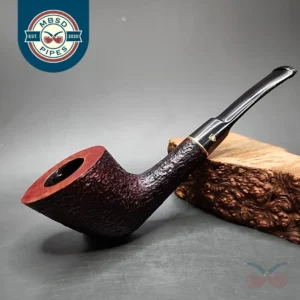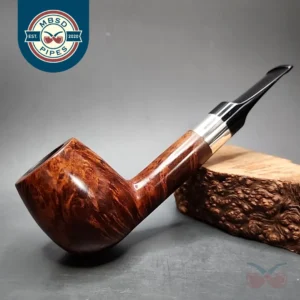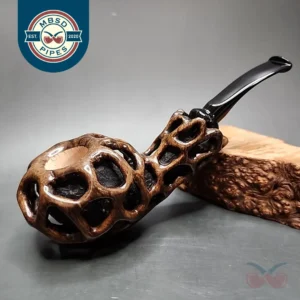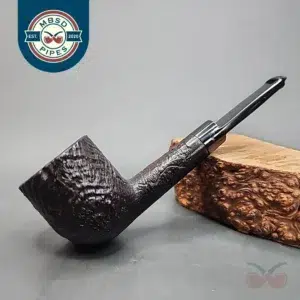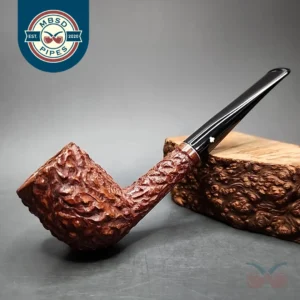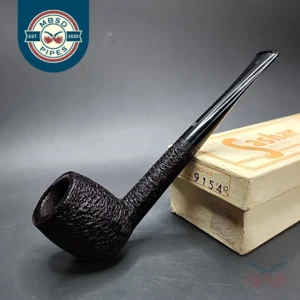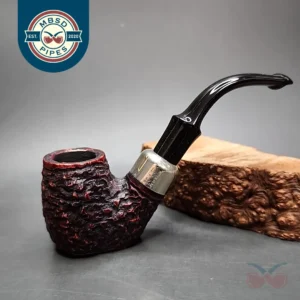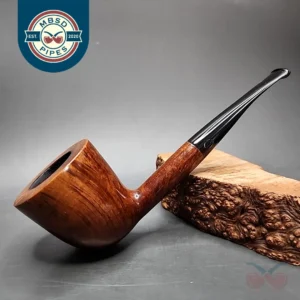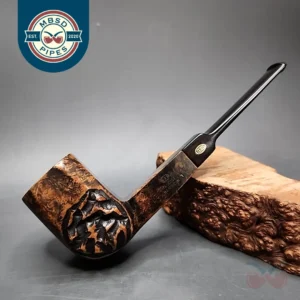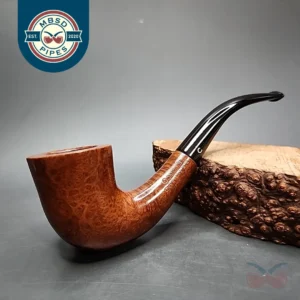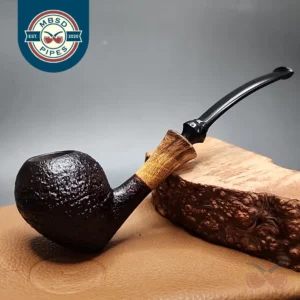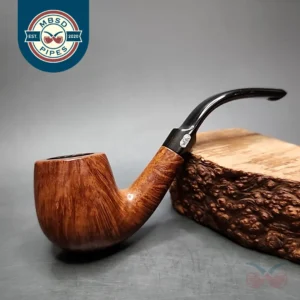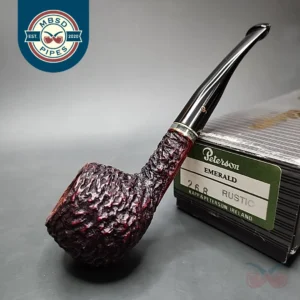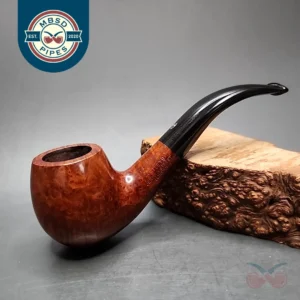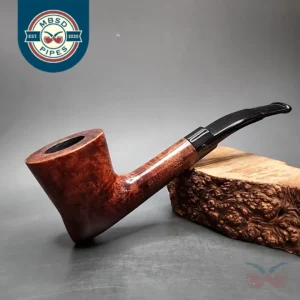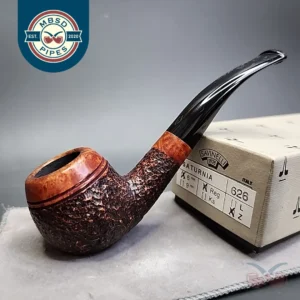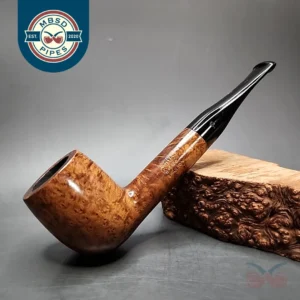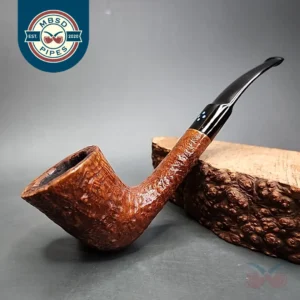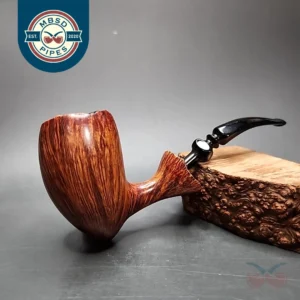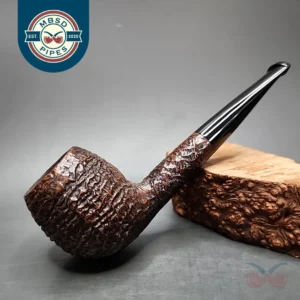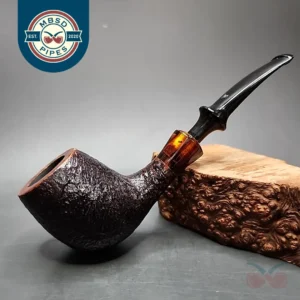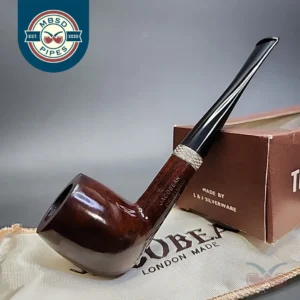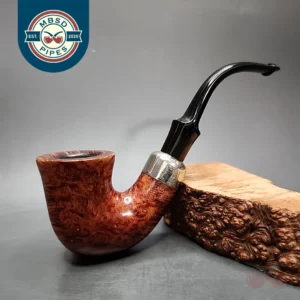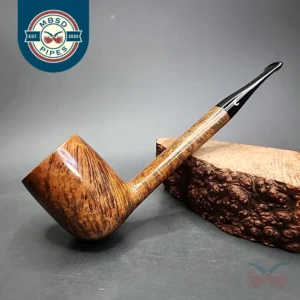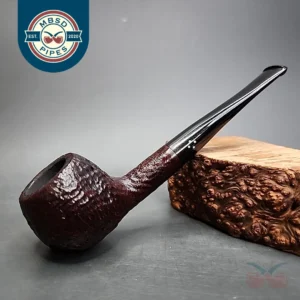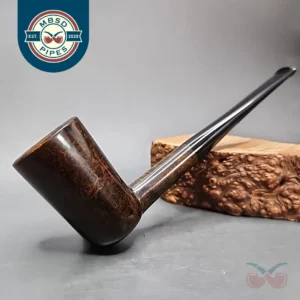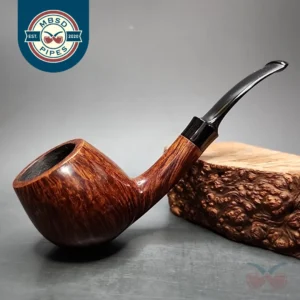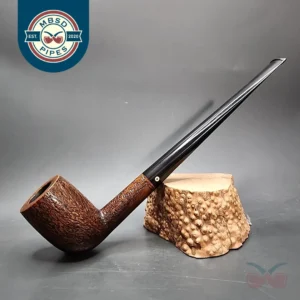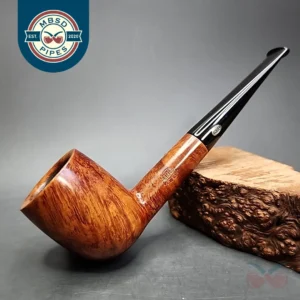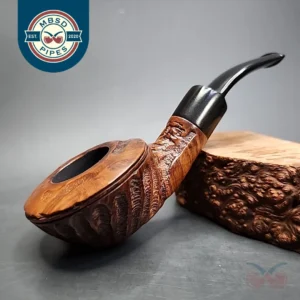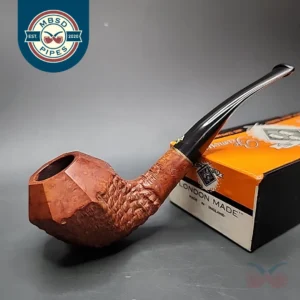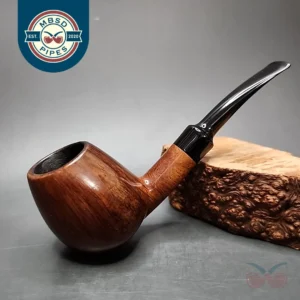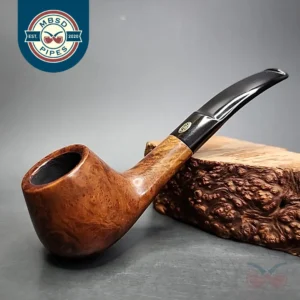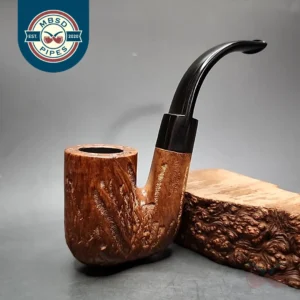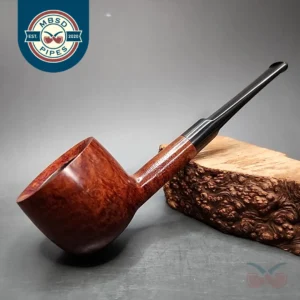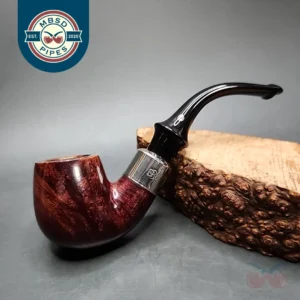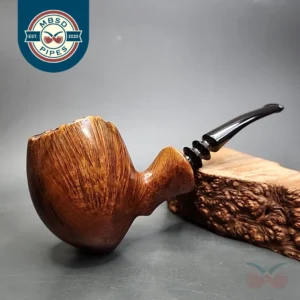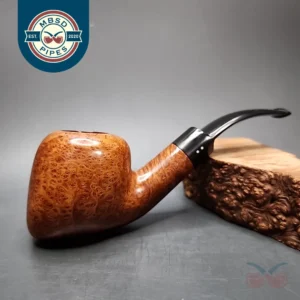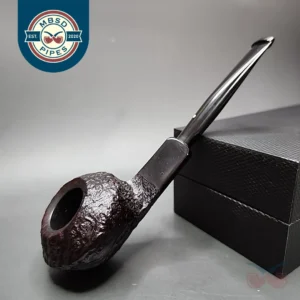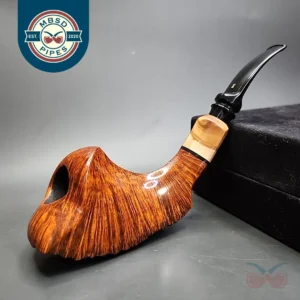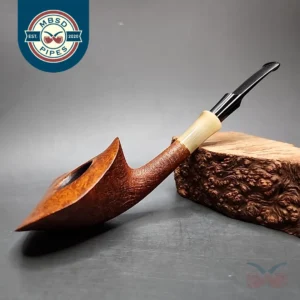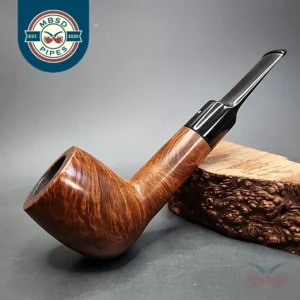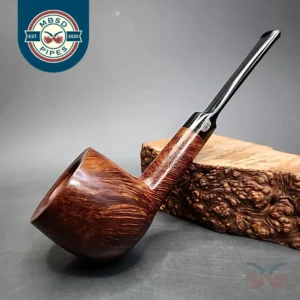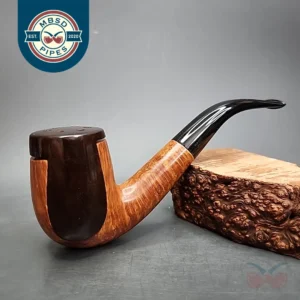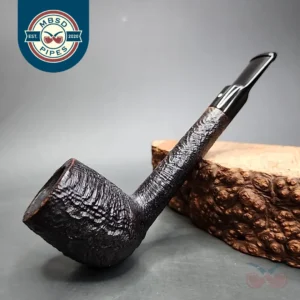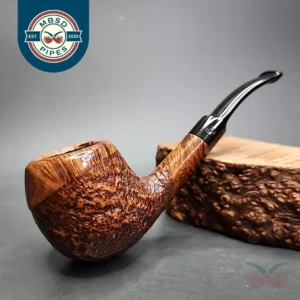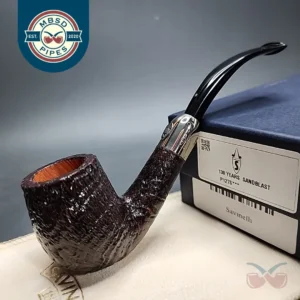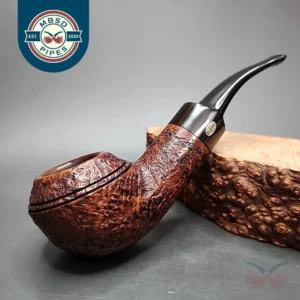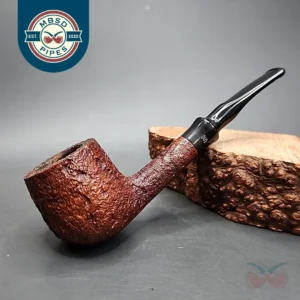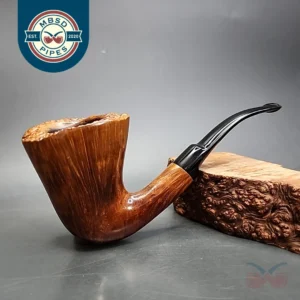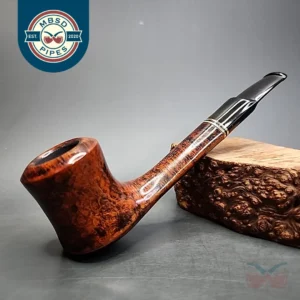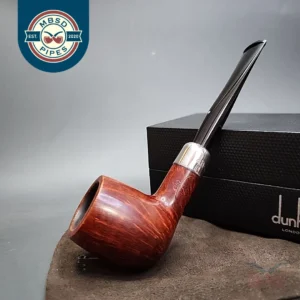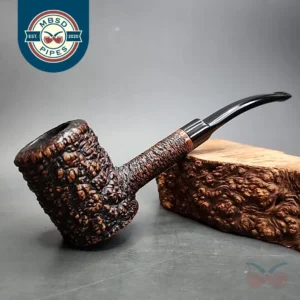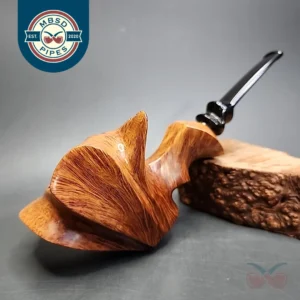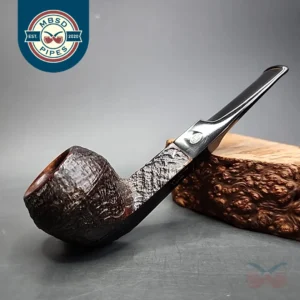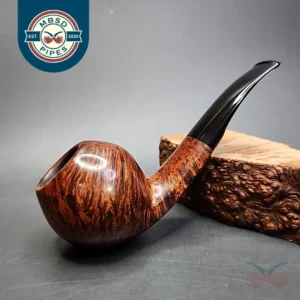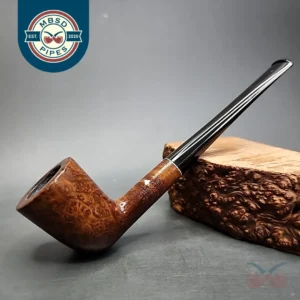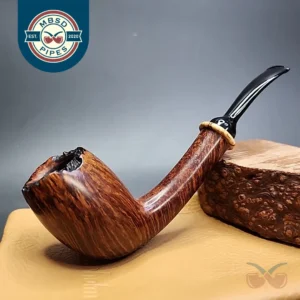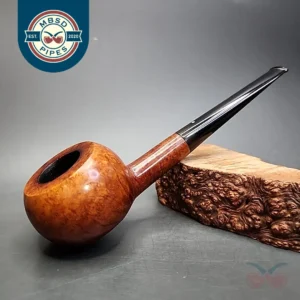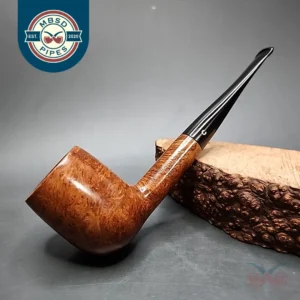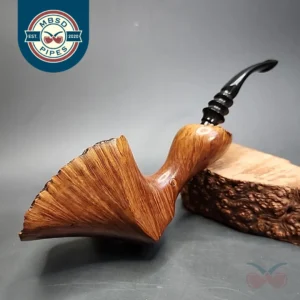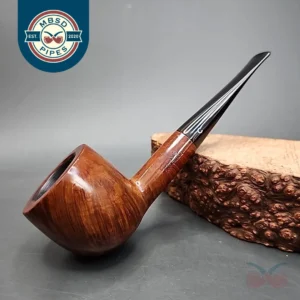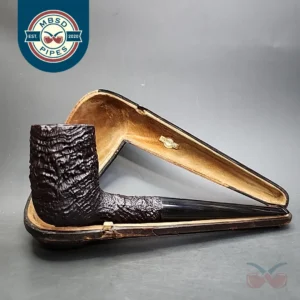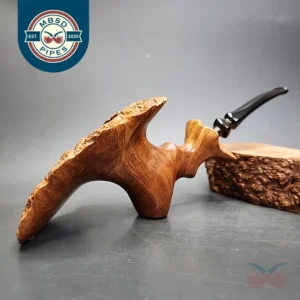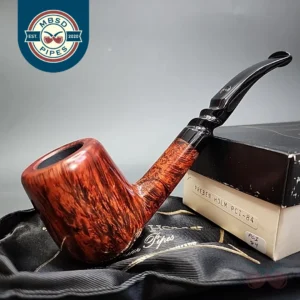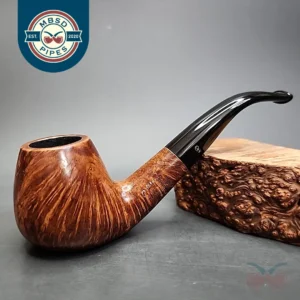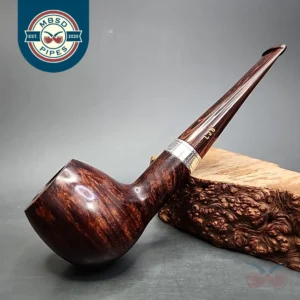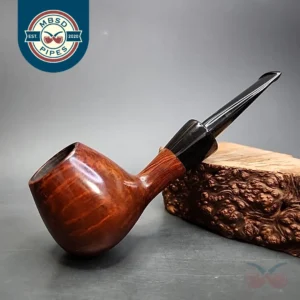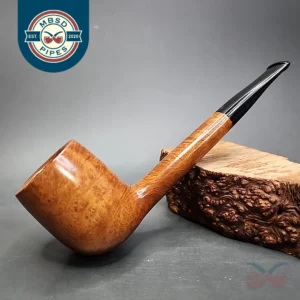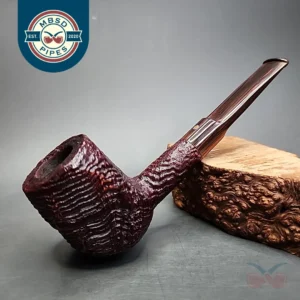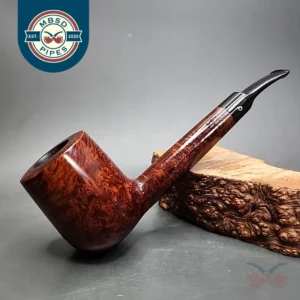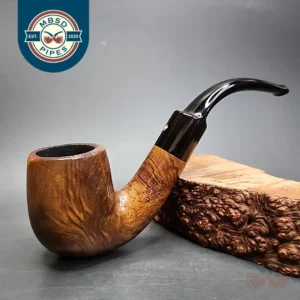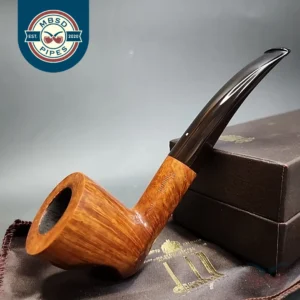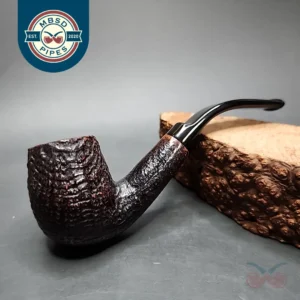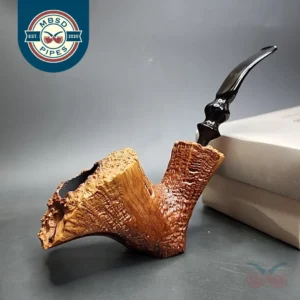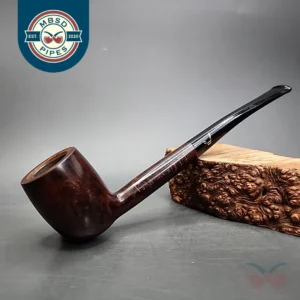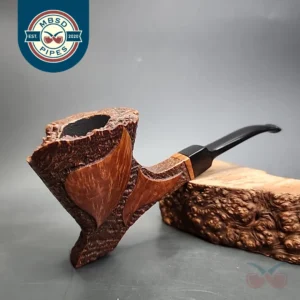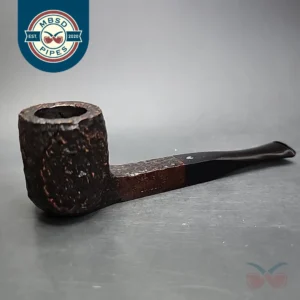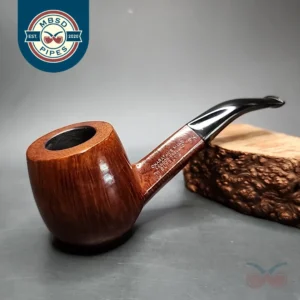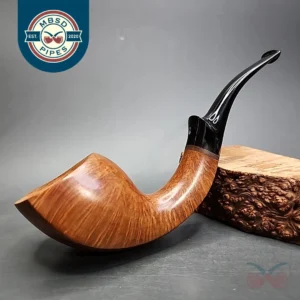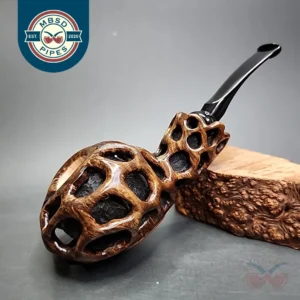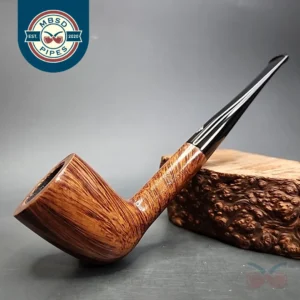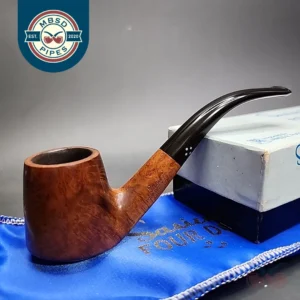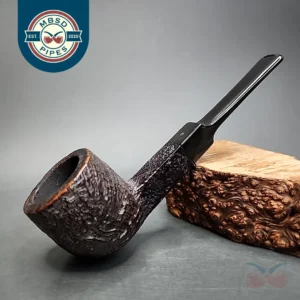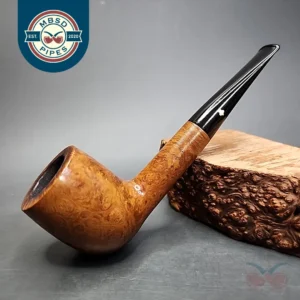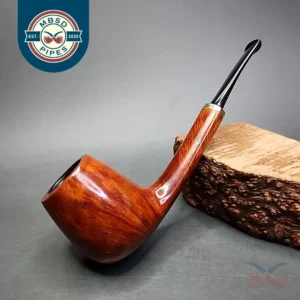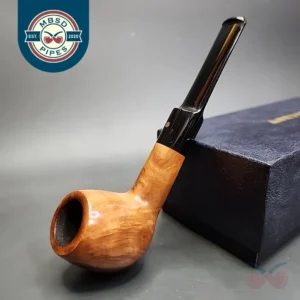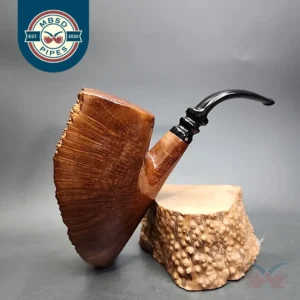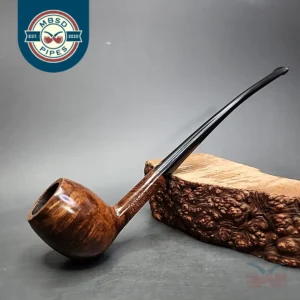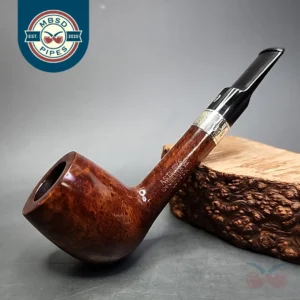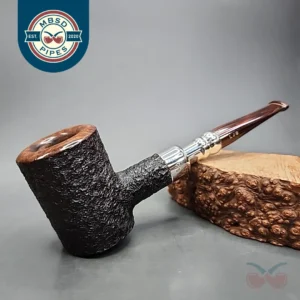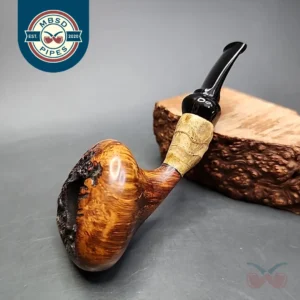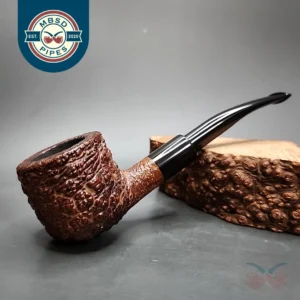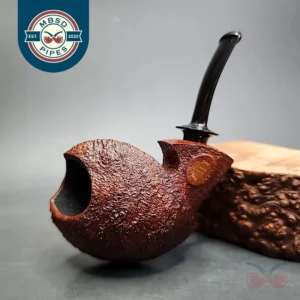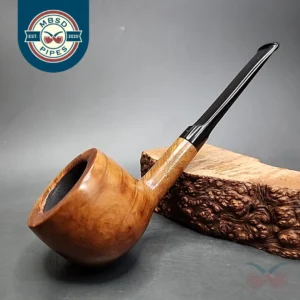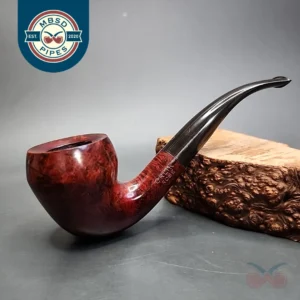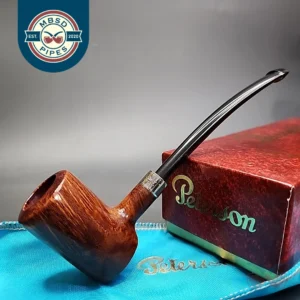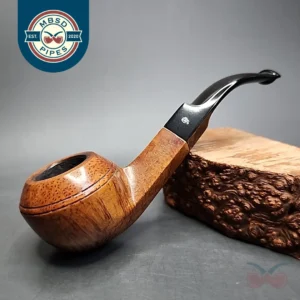Showing 1001–1245 of 1245 resultsSorted by latest
-
Along with names like Barling, Charatan, and Dunhill Sasieni holds a special place in the history of English smoking pipes – one near to its very beginnings. So the story goes, Sasieni himself worked for Dunhill during its early days. But eventually he left Dunhill, having his own ideas about how pipes should be made,…
-
WO Larsen was a tobacconist in Copenhagen Denmark. In the 1960s, when Danish-style pipes were becoming highly sought after, thanks to revolutionary pipe-makers such as Sixten Ivarsson, a workshop was set up on the Larsen premises to produce enough high-grade Danish pipes to meet demand. This workshop was staffed by the emerging masters of Danish…
-
Stanwell is one of Denmark’s most celebrated and enduring pipe companies, having been founded by Poul Nielsen shortly after the second world war. Over the last six decades, Stanwell has established itself as both a leader in innovative Danish design and for producing well-priced pipes with precision construction and engineering. Many of its designs were…
-
If you’re familiar with high-grade pipes – especially those from Denmark – you’ll likely have at least heard of Hans ‘Former’ Nielsen. Former began his career, aged 15, repairing pipes for Poul Rasmussen at Suhr’s Pibemageri. Later, Former was referred to the W.O. Larsen workshop by Rasmussen, where – after an examination by Sven Knudsen,…
-
Comoy’s is a historic brand in pipe making, and possibly the most historic brand in the making of briar pipes. Though originally founded in 1825 by a French family from Saint Claude, France, production of Comoy’s pipes was soon moved to London, England, where it established itself as one of the quintessential English pipe companies….
-
It is probably fair to say that Savinelli is Italy’s most famous pipe brand. Founded in Milan in 1876 by Achille Savinelli, the brand has continuously offered high quality pipes for nearly 150 years. Though various Savinelli lines have come and gone over the years, the brand has always been notable for putting out classically…
-
GBD was one of several prominent examples of a French pipe brand that, due to certain circumstances, became a maker most associated with classic ‘British’ pipes. Founded in 1850 by the French trio Ganneval, Bondier & Donninger, the brand was bought by English company Oppenheimer at the beginning of the 20th century, who opened factories…
-
Pipe Tristan is the name used by French artisan Tristan Lefebvre. Lefebvre is part of a new wave of up-and-coming hand made pipe carvers from the birthplace of briar, following in the footsteps of figures such as Alain Albuisson, Paul Lanier, and Pierre Morel Sr and Jr. Lefebvre credits a wide range of influences upon…
-
Pipe Tristan is the name used by French artisan Tristan Lefebvre. Lefebvre is part of a new wave of up-and-coming hand made pipe carvers from the birthplace of briar, following in the footsteps of figures such as Alain Albuisson, Paul Lanier, and Pierre Morel Sr and Jr. Lefebvre credits a wide range of influences upon…
-
Custom-Bilt pipes were originally created in the early 20th century by Tracy Mincer, an American pipe-maker. Later adopting the slogan, ‘As Individual as a Thumbprint,’ Custom-Bilts were each rusticated by hand, giving them their signature rugged look, and ensuring that no two Custom-Bilts were exactly alike. Today, these pipes are prized by collectors, pipe history…
-
To veteran pipe smokers, Dunhill needs no introduction. Beginning in 1907, Alfred Dunhill began selling Dunhill pipes at the tobacconist shop he owned on London’s Duke Street. Very quickly, these pipes gained the reputation of being the ‘Rolls-Royce’ of pipes due to how expertly crafted they were. Today, Dunhill is likely Britain’s most famous pipe…
-
Along with names like Barling, Charatan, and Dunhill Sasieni holds a special place in the history of English smoking pipes – one near to its very beginnings. So the story goes, Sasieni himself worked for Dunhill during its early days. But eventually he left Dunhill, having his own ideas about how pipes should be made,…
-
To veteran pipe smokers, Dunhill needs no introduction. Beginning in 1907, Alfred Dunhill began selling Dunhill pipes at the tobacconist shop he owned on London’s Duke Street. Very quickly, these pipes gained the reputation of being the ‘Rolls-Royce’ of pipes due to how expertly crafted they were. Today, Dunhill is likely Britain’s most famous pipe…
-
To veteran pipe smokers, Dunhill needs no introduction. Beginning in 1907, Alfred Dunhill began selling Dunhill pipes at the tobacconist shop he owned on London’s Duke Street. Very quickly, these pipes gained the reputation of being the ‘Rolls-Royce’ of pipes due to how expertly crafted they were. Today, Dunhill is likely Britain’s most famous pipe…
-
Barling and Sons was originally founded in 1812 by Benjamin Barling and began as a family business making silver-adorned meerschaum pipes. In the early 20th century, however, the Barling family began to produce what the brand is today most famous for – expertly made briar pipes. If you’ve read our guide to dating Barling pipes,…
-
Mutcat pipes are made by Mutcat Cat, an Indonesian artisan residing in its northeastern Java province. A pipe-maker for many years, and a pipe-smoker for even longer, Mutcat’s pipes are frequently innovative in their use of alternative, home-grown materials and elaborate forms and finishes. This is not only because of a desire to offer pipe-smokers…
-
To veteran pipe smokers, Dunhill needs no introduction. Beginning in 1907, Alfred Dunhill began selling Dunhill pipes at the tobacconist shop he owned on London’s Duke Street. Very quickly, these pipes gained the reputation of being the ‘Rolls-Royce’ of pipes due to how expertly crafted they were. Today, Dunhill is likely Britain’s most famous pipe…
-
Pipe Tristan is the name used by French artisan Tristan Lefebvre. Lefebvre is part of a new wave of up-and-coming hand made pipe carvers from the birthplace of briar, following in the footsteps of figures such as Alain Albuisson, Paul Lanier, and Pierre Morel Sr and Jr. Lefebvre credits a wide range of influences upon…
-
To veteran pipe smokers, Dunhill needs no introduction. Beginning in 1907, Alfred Dunhill began selling Dunhill pipes at the tobacconist shop he owned on London’s Duke Street. Very quickly, these pipes gained the reputation of being the ‘Rolls-Royce’ of pipes due to how expertly crafted they were. Today, Dunhill is likely Britain’s most famous pipe…
-
Custom-Bilt pipes were originally created in the early 20th century by Tracy Mincer, an American pipe-maker. Later adopting the slogan, ‘As Individual as a Thumbprint,’ Custom-Bilts were each rusticated by hand, giving them their signature rugged look, and ensuring that no two Custom-Bilts were exactly alike. Today, these pipes are prized by collectors, pipe history…
-
Along with names like Barling, Charatan, and Dunhill Sasieni holds a special place in the history of English smoking pipes – one near to its very beginnings. So the story goes, Sasieni himself worked for Dunhill during its early days. But eventually he left Dunhill, having his own ideas about how pipes should be made,…
-
Pipe Tristan is the name used by French artisan Tristan Lefebvre. Lefebvre is part of a new wave of up-and-coming hand made pipe carvers from the birthplace of briar, following in the footsteps of figures such as Alain Albuisson, Paul Lanier, and Pierre Morel Sr and Jr. Lefebvre credits a wide range of influences upon…
-
While Dunhill may be Britain’s most famous pipe brand, Charatan is not only older, but has the honor of being the first to have made its pipes entirely in-house. ‘Charatan’s Make’ referred to the fact that, at a time when other pipe companies were sourcing stummels and stems carved from other companies before assembling them…
-
Peterson pipes generally need no introduction, but just in case you’re unfamiliar: in 1876, a Latvian named Charles Peterson immigrated to Ireland and was hired making pipes in a workshop owned by Frederick and George Kapp. After rising through the ranks to become head craftsman, Peterson bought into the Kapp’s business, which was renamed, Kapp…
-
Peterson pipes generally need no introduction, but just in case you’re unfamiliar: in 1876, a Latvian named Charles Peterson immigrated to Ireland and was hired making pipes in a workshop owned by Frederick and George Kapp. After rising through the ranks to become head craftsman, Peterson bought into the Kapp’s business, which was renamed, Kapp…
-
Peterson pipes generally need no introduction, but just in case you’re unfamiliar: in 1876, a Latvian named Charles Peterson immigrated to Ireland and was hired making pipes in a workshop owned by Frederick and George Kapp. After rising through the ranks to become head craftsman, Peterson bought into the Kapp’s business, which was renamed, Kapp…
-
Peterson pipes generally need no introduction, but just in case you’re unfamiliar: in 1876, a Latvian named Charles Peterson immigrated to Ireland and was hired making pipes in a workshop owned by Frederick and George Kapp. After rising through the ranks to become head craftsman, Peterson bought into the Kapp’s business, which was renamed, Kapp…
-
Peterson pipes generally need no introduction, but just in case you’re unfamiliar: in 1876, a Latvian named Charles Peterson immigrated to Ireland and was hired making pipes in a workshop owned by Frederick and George Kapp. After rising through the ranks to become head craftsman, Peterson bought into the Kapp’s business, which was renamed, Kapp…
-
Peterson pipes generally need no introduction, but just in case you’re unfamiliar: in 1876, a Latvian named Charles Peterson immigrated to Ireland and was hired making pipes in a workshop owned by Frederick and George Kapp. After rising through the ranks to become head craftsman, Peterson bought into the Kapp’s business, which was renamed, Kapp…
-
Peterson pipes generally need no introduction, but just in case you’re unfamiliar: in 1876, a Latvian named Charles Peterson immigrated to Ireland and was hired making pipes in a workshop owned by Frederick and George Kapp. After rising through the ranks to become head craftsman, Peterson bought into the Kapp’s business, which was renamed, Kapp…
-
To veteran pipe smokers, Dunhill needs no introduction. Beginning in 1907, Alfred Dunhill began selling Dunhill pipes at the tobacconist shop he owned on London’s Duke Street. Very quickly, these pipes gained the reputation of being the ‘Rolls-Royce’ of pipes due to how expertly crafted they were. Today, Dunhill is likely Britain’s most famous pipe…
-
Barling and Sons was originally founded in 1812 by Benjamin Barling and began as a family business making silver-adorned meerschaum pipes. In the early 20th century, however, the Barling family began to produce what the brand is today most famous for – expertly made briar pipes. This might just be the nicest Barling I’ve had…
-
Peterson pipes generally need no introduction, but just in case you’re unfamiliar: in 1876, a Latvian named Charles Peterson immigrated to Ireland and was hired making pipes in a workshop owned by Frederick and George Kapp. After rising through the ranks to become head craftsman, Peterson bought into the Kapp’s business, which was renamed, Kapp…
-
It is probably fair to say that Savinelli is Italy’s most famous pipe brand. Founded in Milan in 1876 by Achille Savinelli, the brand has continuously offered high quality pipes for nearly 150 years. Though various Savinelli lines have come and gone over the years, the brand has always been notable for putting out classically…
-
Clarence Mickles was a pipe-maker from Illinois, Chicago, and something of a legend within the North American pipe scene. Before making pipes, Mickles was an auto mechanic, which is one reason why he was affectionately known as the ‘Mechanic.’ The other reason is that he was a supremely gifted pipe repairman, in addition to being…
-
Here’s an interesting little pipe. It comes from a workshop in Hong Kong called “HS Studio.” While for many years China has been associated with factories pumping out cheap rosewood pipes, HS Studio is different because, as far as my understanding goes, the pipes are mostly made freehand by artisan carvers, kinda like the great…
-
The origins of the Fieldstub make are as yet unknown, but connections have been drawn to both Custombilt and to Mastercraft, which, in either case, would make it an American make from some time in the 20th century. As such, I’m filing it under American Estates. That, and because the shape is such a quintessentially…
-
To veteran pipe smokers, Dunhill needs no introduction. Beginning in 1907, Alfred Dunhill began selling Dunhill pipes at the tobacconist shop he owned on London’s Duke Street. Very quickly, these pipes gained the reputation of being the ‘Rolls-Royce’ of pipes due to how expertly crafted they were. Today, Dunhill is likely Britain’s most famous pipe…
-
Ashton is an English pipe brand created by William Ashton Taylor, a former Dunhill pipe-maker who left Dunhill in the 1980s to make pipes under his own name. Along with other pipe-makers such as Ken Barnes and Barry Jones of James Upshall and Les Wood of Ferndown, Ashton emerged as part of a new wave…
-
James Upshall was, along with Ferndown and Ashton, part of a new wave of British hand-made, high-grade pipes in the late 20th century, with their founders largely coming from previous positions in the factories of companies such as Dunhill and Charatan. James Upshall was founded in 1978 by Barry Jones and Ken Barnes, both of…
-
Peterson pipes generally need no introduction, but just in case you’re unfamiliar: in 1876, a Latvian named Charles Peterson immigrated to Ireland and was hired making pipes in a workshop owned by Frederick and George Kapp. After rising through the ranks to become head craftsman, Peterson bought into the Kapp’s business, which was renamed, Kapp…
-
WO Larsen was a tobacconist in Copenhagen Denmark. In the 1960s, when Danish-style pipes were becoming highly sought after, thanks to revolutionary pipe-makers such as Sixten Ivarsson, a workshop was set up on the Larsen premises to produce enough high-grade Danish pipes to meet demand. This workshop was staffed by the emerging masters of Danish…
-
To veteran pipe smokers, Dunhill needs no introduction. Beginning in 1907, Alfred Dunhill began selling Dunhill pipes at the tobacconist shop he owned on London’s Duke Street. Very quickly, these pipes gained the reputation of being the ‘Rolls-Royce’ of pipes due to how expertly crafted they were. Today, Dunhill is likely Britain’s most famous pipe…
-
Ernie Markle is an American artisan pipe-maker based in Arizona. Prior to becoming a pipe-maker, Markle had a background in philosophy and Spanish, but had ultimately arrived at a career in finance. Inspired by the creations of contemporary carvers such as Alex Florov, Markle became interested in making his own pipes in the late-2000s. To…
-
Dave Neeb spent the first part of his life as an attorney. Upon retiring, however, he turned his hand to an altogether different vocation: pipes. First, Neeb was a pipe seller; he then learned the art of pipe restoration; finally, under the tutelage of Lee Von Erck and Rad Davis, he took up making artisan…
-
Hardcastle was founded by Edmund Hardcastle in 1906, in London, England. Like many pipe-makers of the time, such as Barling and Sasieni Hardcastle was originally a family-owned business, with its ‘family era’ coming to an end over the course of the years 1936-1946. During this time, Dunhill partially, then fully, bought out the Hardcastle factory…
-
Dave Neeb spent the first part of his life as an attorney. Upon retiring, however, he turned his hand to an altogether different vocation: pipes. First, Neeb was a pipe seller; he then learned the art of pipe restoration; finally, under the tutelage of Lee Von Erck and Rad Davis, he took up making artisan…
-
To veteran pipe smokers, Dunhill needs no introduction. Beginning in 1907, Alfred Dunhill began selling Dunhill pipes at the tobacconist shop he owned on London’s Duke Street. Very quickly, these pipes gained the reputation of being the ‘Rolls-Royce’ of pipes due to how expertly crafted they were. Today, Dunhill is likely Britain’s most famous pipe…
-
Along with figures such as Hans ‘Former’ Nielsen, Anne Julie, and Tom Eltang, Kurt Balleby Hansen is one of the living legends of Danish pipe-making. Balleby celebrated his 40th year in the craft in 2023, having first started as an apprentice to Kai Nielsen and Preben Holm. Owing to a highly selective approach to the…
-
GBD was one of several prominent examples of a French pipe brand that, due to certain circumstances, became a maker most associated with classic ‘British’ pipes. Founded in 1850 by the French trio Ganneval, Bondier & Donninger, the brand was bought by English company Oppenheimer at the beginning of the 20th century, who opened factories…
-
SederCraft pipes are made by Kraig Sederquist, an American artisan based in California. While Sederquist’s pipes vary in shaping and style, his pipes are predominantly freehand, following an ethos of letting the materials used (such as briar) decide what they will be, based on their natural affordances. I’ve been a fan of Kraig Sederquist’s work…
-
GBD was one of several prominent examples of a French pipe brand that, due to certain circumstances, became a maker most associated with classic ‘British’ pipes. Founded in 1850 by the French trio Ganneval, Bondier & Donninger, the brand was bought by English company Oppenheimer at the beginning of the 20th century, who opened factories…
-
Founded in 1947 by Carlo Scotti, Castello quickly became known for producing some of the finest smoking pipes in the world. Over the years, the people involved in making Castello pipes has changed – such as Luigi Radice and Sergio Ascorti, who developed their skills in the Cantu workshop before leaving to start Caminetto, or…
-
Over the last decade, Sean Reum has emerged as one of North America’s most admired and in-demand pipe-makers, with his fans including, among many others, the one and only G.L. Pease. Having followed Reum’s career for many years, including catching a few glimpses of the artisan in his Montana workshop, I’m happy to say that…
-
Astleys was one of London’s most historic pipe and tobacco shops. Like many pipe tobacconists, its owners had pipes made specially to be sold under the shop’s name. Astleys pipes, however, were made by some of the premier pipe manufacturers and artisans in the UK, such as Ashton, Dunhill, Charatan, Les Wood, and Ken Barnes…
-
While Dunhill may be Britain’s most famous pipe brand, Charatan is not only older, but has the honor of being the first to have made its pipes entirely in-house. ‘Charatan’s Make’ referred to the fact that, at a time when other pipe companies were sourcing stummels and stems carved from other companies before assembling them…
-
WO Larsen was a tobacconist in Copenhagen Denmark. In the 1960s, when Danish-style pipes were becoming highly sought after, thanks to revolutionary pipe-makers such as Sixten Ivarsson, a workshop was set up on the Larsen premises to produce enough high-grade Danish pipes to meet demand. This workshop was staffed by the emerging masters of Danish…
-
Named for the company’s home township, Brebbia was founded in 1953 by Enea Buzzi, an alum of Savinelli’s manufacturing division. Still in operation 70 years later, Brebbia is one of Italy’s oldest extant pipe companies, with production still being undertaken using simple lathes and traditional methods of hand finishing. More recently, Brebbia has also collaborated…
-
Alongside near-contemporaries such as Otto Pollner and Karlheinz Joura, Rainer Barbi was one of the ‘grand old men’ of German artisan pipe-making. Beginning his career in the 1970s, Barbi was largely self-taught, but nevertheless managed to establish a reputation as one of the most talented freehand pipe carvers in the world. In his later years,…
-
It is probably fair to say that Savinelli is Italy’s most famous pipe brand. Founded in Milan in 1876 by Achille Savinelli, the brand has continuously offered high quality pipes for nearly 150 years. Though various Savinelli lines have come and gone over the years, the brand has always been notable for putting out classically…
-
E. Wilke is one of America’s most historic tobacconists, and one of the few to remain in operation to this day. Founded in 1872 by Edwin Wilke, Wilke was not only a supplier of fine pipe tobacco but was distinct from many other tobacconists of the time due to Wilke-brand pipes being made in-house, by…
-
To veteran pipe smokers, Dunhill needs no introduction. Beginning in 1907, Alfred Dunhill began selling Dunhill pipes at the tobacconist shop he owned on London’s Duke Street. Very quickly, these pipes gained the reputation of being the ‘Rolls-Royce’ of pipes due to how expertly crafted they were. Today, Dunhill is likely Britain’s most famous pipe…
-
Astleys was one of London’s most historic pipe and tobacco shops. Like many pipe tobacconists, its owners had pipes made specially to be sold under the shop’s name. Astleys pipes, however, were made by some of the premier pipe manufacturers and artisans in the UK, such as Dunhill, Charatan, Les Wood, and Ken Barnes and…
-
While Dunhill may be Britain’s most famous pipe brand, Charatan is not only older, but has the honor of being the first to have made its pipes entirely in-house. ‘Charatan’s Make’ referred to the fact that, at a time when other pipe companies were sourcing stummels and stems carved from other companies before assembling them…
-
It is said that Irwin’s was a sub-brand of GBD. Given that this 1345 is a dead ringer for GBD’s main-line shape 1345 pot-poker, I’m inclined to agree. The condition is fair. There’s certainly some rim darkening, especially at the rear section of the rim, but that won’t stop it from being a reliable smoker,…
-
Along with names like Barling, Charatan, and Dunhill Sasieni holds a special place in the history of English smoking pipes – one near to its very beginnings. So the story goes, Sasieni himself worked for Dunhill during its early days. But eventually he left Dunhill, having his own ideas about how pipes should be made,…
-
Jody Davis is a rockstar – literally. As a member of the Nashville rock group The Newsboys, he doesn’t have much time to make pipes these days, meaning his output is very limited. He’s also a rockstar in the pipe world, which makes the few pipes that he does put out each year extremely coveted….
-
Sale!
Along with names like Barling, Charatan, and Dunhill Sasieni holds a special place in the history of English smoking pipes – one near to its very beginnings. So the story goes, Sasieni himself worked for Dunhill during its early days. But eventually he left Dunhill, having his own ideas about how pipes should be made,…
-
To veteran pipe smokers, Dunhill needs no introduction. Beginning in 1907, Alfred Dunhill began selling Dunhill pipes at the tobacconist shop he owned on London’s Duke Street. Very quickly, these pipes gained the reputation of being the ‘Rolls-Royce’ of pipes due to how expertly crafted they were. Today, Dunhill is likely Britain’s most famous pipe…
-
GBD was one of several prominent examples of a French pipe brand that, due to certain circumstances, became a maker most associated with classic ‘British’ pipes. Founded in 1850 by the French trio Ganneval, Bondier & Donninger, the brand was bought by English company Oppenheimer at the beginning of the 20th century, who opened factories…
-
To veteran pipe smokers, Dunhill needs no introduction. Beginning in 1907, Alfred Dunhill began selling Dunhill pipes at the tobacconist shop he owned on London’s Duke Street. Very quickly, these pipes gained the reputation of being the ‘Rolls-Royce’ of pipes due to how expertly crafted they were. Today, Dunhill is likely Britain’s most famous pipe…
-
Barling and Sons was originally founded in 1812 by Benjamin Barling and began as a family business making silver-adorned meerschaum pipes. In the early 20th century, however, the Barling family began to produce what the brand is today most famous for – expertly made briar pipes. This particular Barling, from the make’s post-transition era, is…
-
In the world of pipes, Tom Eltang needs no introduction. I will, however, give one anyway, if just as a reminder. Eltang made his first pipe from a Pipe-Dan hobby kit at the age of 11. At age 16, he apprenticed under the legendary Anne Julie, before moving on to work for Pibe-Dan three years…
-
It is probably fair to say that Savinelli is Italy’s most famous pipe brand. Founded in Milan in 1876 by Achille Savinelli, the brand has continuously offered high quality pipes for nearly 150 years. Though various Savinelli lines have come and gone over the years, the brand has always been notable for putting out classically…
-
To veteran pipe smokers, Dunhill needs no introduction. Beginning in 1907, Alfred Dunhill began selling Dunhill pipes at the tobacconist shop he owned on London’s Duke Street. Very quickly, these pipes gained the reputation of being the ‘Rolls-Royce’ of pipes due to how expertly crafted they were. Today, Dunhill is likely Britain’s most famous pipe…
-
While Dunhill may be Britain’s most famous pipe brand, Charatan is not only older, but has the honor of being the first to have made its pipes entirely in-house. ‘Charatan’s Make’ referred to the fact that, at a time when other pipe companies were sourcing stummels and stems carved from other companies before assembling them…
-
Along with names like Barling, Charatan, and Dunhill Sasieni holds a special place in the history of English smoking pipes – one near to its very beginnings. So the story goes, Sasieni himself worked for Dunhill during its early days. But eventually he left Dunhill, having his own ideas about how pipes should be made,…
-
Astleys was one of London’s most historic pipe and tobacco shops. Like many pipe tobacconists, its owners had pipes made specially to be sold under the shop’s name. Astleys pipes, however, were made by some of the premier pipe manufacturers and artisans in the UK, such as Dunhill, Charatan, Les Wood, and Ken Barnes and…
-
While Dunhill may be Britain’s most famous pipe brand, Charatan is not only older, but has the honor of being the first to have made its pipes entirely in-house. ‘Charatan’s Make’ referred to the fact that, at a time when other pipe companies were sourcing stummels and stems carved from other companies before assembling them…
-
Andreas Bennwik is a Swedish artisan from the country’s capital, Stockholm. Bennwik has a background in sculpture and illustration, the latter of which still remaining one half of his working life. The other half is, of course, pipe-making. Bennwik’s journey into the craft followed a course common to many artisans: first, as a simple smoker…
-
Among today’s vibrant scene of high-grade artisan pipe-makers, there are yet few who command as much respect as Jess Chonowitsch. He began his career in 1966, working alongside his father, Emil, at Teofil Suhr’s workshop and under Poul Rasmussen’s direction. After Rasmussen’s passing in 1967, Jess joined the W.O. Larsen workshop alongside other budding masters,…
-
Michel pipes were store-brand pipes made for Maison Michel, a North Carolina (USA) tobacconist run by Michel J. Mitchell between 1951 and 1980. Over the years, several prominent pipe-makers made pipes for Maison Michel, such as Charatan, Barling, and others. This particular Michel comes from the make’s Natural series, named for its light, almost naked…
-
To veteran pipe smokers, Dunhill needs no introduction. Beginning in 1907, Alfred Dunhill began selling Dunhill pipes at the tobacconist shop he owned on London’s Duke Street. Very quickly, these pipes gained the reputation of being the ‘Rolls-Royce’ of pipes due to how expertly crafted they were. Today, Dunhill is likely Britain’s most famous pipe…
-
The Tinder Box is a historic North American tobacconist, originally founded in 1928. Over the years, a number of established pipe manufacturers have produced pipes for The Tinder Box house-brand, including Charatan, Savinelli, and Ascorti. From what I’ve read, the Unique series from The Tinder Box was made by Charatan. That this pipe’s stamping states…
-
While Dunhill may be Britain’s most famous pipe brand, Charatan is not only older, but has the honor of being the first to have made its pipes entirely in-house. ‘Charatan’s Make’ referred to the fact that, at a time when other pipe companies were sourcing stummels and stems carved from other companies before assembling them…
-
H.T.L. pipes are a little mysterious, but it has been suggested that these pipes were a house-brand for Californian tobacconist Hiland’s Tobacco Locker (with one person suggesting this having worked at a Hiland’s branch in years past). The pipes were made for Hiland’s by established makes of the time, including Savinelli, Comoy’s and GBD. This…
-
It’s a cliche, I know, but when I think of Anne Julie I am reminded of the mythical phoenix, rising from the ashes. This is because the impetus for Julie becoming a pipe-maker was tragedy. Her husband, Poul Rasmussen, ran Suhr’s Pipemageri (a Danish word for pipe workshop) in Denmark and was, along with other…
-
Astleys was one of London’s most historic pipe and tobacco shops. Like many pipe tobacconists, its owners had pipes made specially to be sold under the shop’s name. Astleys pipes, however, were made by some of the premier pipe manufacturers and artisans in the UK, such as Dunhill, Charatan, Les Wood, and Ken Barnes and…
-
It is probably fair to say that Savinelli is Italy’s most famous pipe brand. Founded in Milan in 1876 by Achille Savinelli, the brand has continuously offered high quality pipes for nearly 150 years. Though various Savinelli lines have come and gone over the years, the brand has always been notable for putting out classically…
-
Originally founded in 1968 by Svend Bang, a former store manager at Denmark’s legendary W.Ø. Larsen, S. Bang would go on to become a legend in its own right, one that would rival even Larsen in fame and acclaim. While Svend himself was not a pipe-maker, he was able to enlist some of the most…
-
Sale!
While some pipe-makers take inspiration from the natural world, or from the technologies of present and past, few of them in the contemporary seek to represent these forms in their work. Czech artisan Ondrej Bárta of Moonlight pipes does just that, in a way that recalls the intricate, figural carvings of briar pipes from the…
-
Peterson pipes generally need no introduction, but just in case you’re unfamiliar: in 1876, a Latvian named Charles Peterson immigrated to Ireland and was hired making pipes in a workshop owned by Frederick and George Kapp. After rising through the ranks to become head craftsman, Peterson bought into the Kapp’s business, which was renamed, Kapp…
-
Kaywoodie pipes are as American as apple pie. Starting in 1919 as a pipe brand for KB&B, a pipe shop dating all the way back to 1851, Kaywoodie has since then been a staple of American-made pipes. In the present, many Kaywoodies are collectors’ items, in addition to being fantastic smokers. Kaywoodie’s Natural Burl was…
-
James Upshall was, along with Ferndown and Ashton, part of a new wave of British hand-made, high-grade pipes in the late 20th century, with their founders largely coming from previous positions in the factories of companies such as Dunhill and Charatan. James Upshall was founded in 1978 by Barry Jones and Ken Barnes, both of…
-
Along with names like Barling, Charatan, and Dunhill Sasieni holds a special place in the history of English smoking pipes – one near to its very beginnings. So the story goes, Sasieni himself worked for Dunhill during its early days. But eventually he left Dunhill, having his own ideas about how pipes should be made,…
-
Dr Grabow might just be the quintessential American working man’s pipe. Created in 1932 by Linkman & Co., the Dr Grabow name soon became a staple in the American pipe world, being still produced today and enjoyed by novices and veterans alike. Details: Length: 12″ / 304.8mm Bowl Width: 0.76 / 19.30mm Bowl Depth:…
-
Peterson pipes generally need no introduction, but just in case you’re unfamiliar: in 1876, a Latvian named Charles Peterson immigrated to Ireland and was hired making pipes in a workshop owned by Frederick and George Kapp. After rising through the ranks to become head craftsman, Peterson bought into the Kapp’s business, which was renamed, Kapp…
-
James Upshall was, along with Ferndown and Ashton, part of a new wave of British hand-made, high-grade pipes in the late 20th century, with their founders largely coming from previous positions in the factories of companies such as Dunhill and Charatan. James Upshall was founded in 1978 by Barry Jones and Ken Barnes, both of…
-
GBD was one of several prominent examples of a French pipe brand that, due to certain circumstances, became a maker most associated with classic ‘British’ pipes. Founded in 1850 by the French trio Ganneval, Bondier & Donninger, the brand was bought by English company Oppenheimer at the beginning of the 20th century, who opened factories…
-
Doctor’s Pipes are made by artisan pipe-maker Roman Kovalev. Based in Saint Petersburg, Kovalev’s pipe-making moniker derives from his sixteen years spent as a pediatric neurologist, and the consequent nickname of ‘Doc’ given by his friends. Taking up pipe-making in the early 2010s, and with a great deal of inspiration from Japanese masters such as…
-
Comoy’s is a historic brand in pipe making, and possibly the most historic brand in the making of briar pipes. Though originally founded in 1825 by a French family from Saint Claude, France, production of Comoy’s pipes was soon moved to London, England, where it established itself as one of the quintessential English pipe companies….
-
Born and raised in the small town of Gueydan, Louisana, Jay Mouton is an American artisan who works under the moniker of J. Mouton. Having crafted duck calls since he was a teenager, Mouton’s first forays into pipe-making began with carving tampers. Mouton’s unexpected successes with these handmade tampers allowed him to purchase the equipment…
-
Weber Pipe Co. was a major American pipe company established by German immigrant Carl B. Weber in 1938, also known for writing the book Weber’s Guide to Pipes and Pipe Smoking. In addition to manufacturing Weber pipes, WPC also manufactured Jobey pipes and contracted Karl Erik to produce the Jobey Dansk line during the Danish…
-
Peterson pipes generally need no introduction, but just in case you’re unfamiliar: in 1876, a Latvian named Charles Peterson immigrated to Ireland and was hired making pipes in a workshop owned by Frederick and George Kapp. After rising through the ranks to become head craftsman, Peterson bought into the Kapp’s business, which was renamed, Kapp…
-
Astleys was one of London’s most historic pipe and tobacco shops. Like many pipe tobacconists, its owners had pipes made specially to be sold under the shop’s name. Astleys pipes, however, were made by some of the premier pipe manufacturers and artisans in the UK, such as Dunhill, Charatan, Les Wood, and Ken Barnes and…
-
While Dunhill may be Britain’s most famous pipe brand, Charatan is not only older, but has the honor of being the first to have made its pipes entirely in-house. ‘Charatan’s Make’ referred to the fact that, at a time when other pipe companies were sourcing stummels and stems carved from other companies before assembling them…
-
Born and raised in the small town of Gueydan, Louisana, Jay Mouton is an American artisan who works under the moniker of J. Mouton. Having crafted duck calls since he was a teenager, Mouton’s first forays into pipe-making began with carving tampers. Mouton’s unexpected successes with these handmade tampers allowed him to purchase the equipment…
-
It is probably fair to say that Savinelli is Italy’s most famous pipe brand. Founded in Milan in 1876 by Achille Savinelli, the brand has continuously offered high quality pipes for nearly 150 years. Though various Savinelli lines have come and gone over the years, the brand has always been notable for putting out classically…
-
Peterson pipes generally need no introduction, but just in case you’re unfamiliar: in 1876, a Latvian named Charles Peterson immigrated to Ireland and was hired making pipes in a workshop owned by Frederick and George Kapp. After rising through the ranks to become head craftsman, Peterson bought into the Kapp’s business, which was renamed, Kapp…
-
Along with names like Barling, Charatan, and Dunhill Sasieni holds a special place in the history of English smoking pipes – one near to its very beginnings. So the story goes, Sasieni himself worked for Dunhill during its early days. But eventually he left Dunhill, having his own ideas about how pipes should be made,…
-
Nørding was founded by Erik Nørding in the 1960s, and is one of the oldest remaining companies to come out of the Scandinavian pipe-making renaissance that began in the mid-20th century. Now in his 80s, Erik Nørding is one of the most experienced and skilled pipe-makers in the world, and over the decades he has…
-
Barling and Sons was originally founded in 1812 by Benjamin Barling and began as a family business making silver-adorned meerschaum pipes. In the early 20th century, however, the Barling family began to produce what the brand is today most famous for – expertly made briar pipes. For those that don’t know, Barling pipes can be…
-
Originally founded in 1968 by Svend Bang, a former store manager at Denmark’s legendary W.Ø. Larsen, S. Bang would go on to become a legend in its own right, one that would rival even Larsen in fame and acclaim. While Svend himself was not a pipe-maker, he was able to enlist some of the most…
-
Stanwell is one of Denmark’s most celebrated and enduring pipe companies, having been founded by Poul Nielsen shortly after the second world war. Over the last six decades, Stanwell has established itself as both a leader in innovative Danish design and for producing well-priced pipes with precision construction and engineering. Many of its designs were…
-
This pipe requires some explaining. In fact, it requires quite a lot of explaining, which will be covered more extensively in our upcoming interview with the now-retired pipe-maker Les Wood. Because that interview is taking more time than expected to edit, I figured I’d ask the interviewer, James, to let me know the basic story…
-
Peterson pipes generally need no introduction, but just in case you’re unfamiliar: in 1876, a Latvian named Charles Peterson immigrated to Ireland and was hired making pipes in a workshop owned by Frederick and George Kapp. After rising through the ranks to become head craftsman, Peterson bought into the Kapp’s business, which was renamed, Kapp…
-
Comoy’s is a historic brand in pipe making, and possibly the most historic brand in the making of briar pipes. Though originally founded in 1825 by a French family from Saint Claude, France, production of Comoy’s pipes was soon moved to London, England, where it established itself as one of the quintessential English pipe companies….
-
Along with names like Barling, Charatan, and Dunhill Sasieni holds a special place in the history of English smoking pipes – one near to its very beginnings. So the story goes, Sasieni himself worked for Dunhill during its early days. But eventually he left Dunhill, having his own ideas about how pipes should be made,…
-
Dave Neeb spent the first part of his life as an attorney. Upon retiring, however, he turned his hand to an altogether different vocation: pipes. First, Neeb was a pipe seller; he then learned the art of pipe restoration; finally, under the tutelage of Lee Von Erck and Rad Davis, he took up making artisan…
-
Born and raised in the small town of Gueydan, Louisana, Jay Mouton is an American artisan who works under the moniker of J. Mouton. Having crafted duck calls since he was a teenager, Mouton’s first forays into pipe-making began with carving tampers. Mouton’s unexpected successes with these handmade tampers allowed him to purchase the equipment…
-
Born and raised in the small town of Gueydan, Louisana, Jay Mouton is an American artisan who works under the moniker of J. Mouton. Having crafted duck calls since he was a teenager, Mouton’s first forays into pipe-making began with carving tampers. Mouton’s unexpected successes with these handmade tampers allowed him to purchase the equipment…
-
Nørding was founded by Erik Nørding in the 1960s, and is one of the oldest remaining companies to come out of the Scandinavian pipe-making renaissance that began in the mid-20th century. Now in his 80s, Erik Nørding is one of the most experienced and skilled pipe-makers in the world, and over the decades he has…
-
Originally founded in 1968 by Svend Bang, a former store manager at Denmark’s legendary W.Ø. Larsen, S. Bang would go on to become a legend in its own right, one that would rival even Larsen in fame and acclaim. While Svend himself was not a pipe-maker, he was able to enlist some of the most…
-
Peter Brakner (né Micklson) was one of the godfathers of the Danish pipe-making movement that emerged in the mid-20th century. He began his career at Suhr’s Pibemageri, a pipe workshop whose foreman at the time was Sixten Ivarsson. There he also met Poul Rasmussen, who took over as foreman after Ivarsson departed. Along with Ivarsson…
-
Astleys was one of London’s most historic pipe and tobacco shops. Like many pipe tobacconists, its owners had pipes made specially to be sold under the shop’s name. Astleys pipes, however, were made by some of the premier pipe manufacturers and artisans in the UK, such as Dunhill, Charatan, Les Wood, and Ken Barnes and…
-
GBD was one of several prominent examples of a French pipe brand that, due to certain circumstances, became a maker most associated with classic ‘British’ pipes. Founded in 1850 by the French trio Ganneval, Bondier & Donninger, the brand was bought by English company Oppenheimer at the beginning of the 20th century, who opened factories…
-
It appears that the stamping on this pipe was buffed off over time, leading me to be unable to identify who made it. But, there’s an obvious connection to one pipe make in the design: Custom-bilt, or Custombilt as it later came to be known. Whether this is a Custombilt pipe or simply a maker…
-
‘BBB’ originally stood for ‘Blumfeld’s Best Briars’, so named after Louis Blumfeld after he took over the historic Alfred Frankenau Company in 1856. Later, the pipes came to be known as ‘Britain’s Best Briars’. Though the name might have changed, the quality of the pipes did not – they really were fantastic pipes, made in…
-
WO Larsen was a tobacconist in Copenhagen Denmark. In the 1960s, when Danish-style pipes were becoming highly sought after, thanks to revolutionary pipe-makers such as Sixten Ivarsson, a workshop was set up on the Larsen premises to produce enough high-grade Danish pipes to meet demand. This workshop was staffed by the emerging masters of Danish…
-
GBD was one of several prominent examples of a French pipe brand that, due to certain circumstances, became a maker most associated with classic ‘British’ pipes. Founded in 1850 by the French trio Ganneval, Bondier & Donninger, the brand was bought by English company Oppenheimer at the beginning of the 20th century, who opened factories…
-
Custom-Bilt (later, as in this case, Custombilt) pipes were originally created in the early 20th century by Tracy Mincer, an American pipe-maker. Later adopting the slogan, ‘As Individual as a Thumbprint,’ Custom-Bilts were each rusticated by hand, giving them their signature rugged look, and ensuring that no two Custom-Bilts were exactly alike. Today, these pipes…
-
While Dunhill may be Britain’s most famous pipe brand, Charatan is not only older, but has the honor of being the first to have made its pipes entirely in-house. ‘Charatan’s Make’ referred to the fact that, at a time when other pipe companies were sourcing stummels and stems carved from other companies before assembling them…
-
Doctor’s Pipes are made by artisan pipe-maker Roman Kovalev. Based in Saint Petersburg, Kovalev’s pipe-making moniker derives from his sixteen years spent as a pediatric neurologist, and the consequent nickname of ‘Doc’ given by his friends. Taking up pipe-making in the early 2010s, and with a great deal of inspiration from Japanese masters such as…
-
KB&B, or Kaufmann Bros & Bondy, was an American pipe company established in the mid-19th century, most famous today for having created Kaywoodie. The company originally made pipes under the KB&B name, but their innovative designs and patents soon led them to market several makes under the KB&B umbrella, including Kaywoodie, Yello-Bole, and CPF. From…
-
Knute was one of several makes crafted by Karl Erik during his lifetime. Erik himself was a Danish pipe-maker, and one of the originators of the Danish style of pipe-making that swept the world in the 20th century. He was a prolific carver and many who apprenticed in his workshop went on to become iconic…
-
Along with names like Barling, Charatan, and Dunhill Sasieni holds a special place in the history of English smoking pipes – one near to its very beginnings. So the story goes, Sasieni himself worked for Dunhill during its early days. But eventually he left Dunhill, having his own ideas about how pipes should be made,…
-
To veteran pipe smokers, Dunhill needs no introduction. Beginning in 1907, Alfred Dunhill began selling Dunhill pipes at the tobacconist shop he owned on London’s Duke Street. Very quickly, these pipes gained the reputation of being the ‘Rolls-Royce’ of pipes due to how expertly crafted they were. Today, Dunhill is likely Britain’s most famous pipe…
-
Karl Erik was a Danish pipe-maker, and one of the originators of the Danish style of pipe-making that swept the world in the 20th century. He was a prolific carver and many who apprenticed in his workshop went on to become iconic pipe-makers in their own right, such as Peder Jeppesen and Bent Nielsen (Benner)….
-
A graduate of industrial design and of a less formal apprenticeship under Todd Johnson, Adam Davidson has become one of North America’s most renowned artisan pipe-makers. Davidson initially worked with Johnson on his Medici pipes, while also being employed as a refurbisher for one of America’s leading pipe dealers. He then went solo, soon rising…
-
To veteran pipe smokers, Dunhill needs no introduction. Beginning in 1907, Alfred Dunhill began selling Dunhill pipes at the tobacconist shop he owned on London’s Duke Street. Very quickly, these pipes gained the reputation of being the ‘Rolls-Royce’ of pipes due to how expertly crafted they were. Today, Dunhill is likely Britain’s most famous pipe…
-
GBD was one of several prominent examples of a French pipe brand that, due to certain circumstances, became a maker most associated with classic ‘British’ pipes. Founded in 1850 by the French trio Ganneval, Bondier & Donninger, the brand was bought by English company Oppenheimer at the beginning of the 20th century, who opened factories…
-
Peterson pipes generally need no introduction, but just in case you’re unfamiliar: in 1876, a Latvian named Charles Peterson immigrated to Ireland and was hired making pipes in a workshop owned by Frederick and George Kapp. After rising through the ranks to become head craftsman, Peterson bought into the Kapp’s business, which was renamed, Kapp…
-
While there are many historic tobacconists, few can claim to be quite as historic as Fribourg & Treyer. Situated in London’s Westminster borough, Fribourg & Treyer was founded in 1720, and continued its operations until its closure in 1980. As with many major tobacconists, Fribourg & Treyer had house-make briar pipes created for their shops…
-
To veteran pipe smokers, Dunhill needs no introduction. Beginning in 1907, Alfred Dunhill began selling Dunhill pipes at the tobacconist shop he owned on London’s Duke Street. Very quickly, these pipes gained the reputation of being the ‘Rolls-Royce’ of pipes due to how expertly crafted they were. Today, Dunhill is likely Britain’s most famous pipe…
-
Joao Madail, who also operates under the Scorpius Pipes moniker, is an artisan pipe-maker based in Portugal. Madail began pipe-making in 2010, under the guidance of another Joao – the renowned Brazilian pipe-maker Joao Reis. The horn shape is a thoroughly modern one, and as with most things modern in pipe-making, owes its birth to…
-
Stanwell is one of Denmark’s most celebrated and enduring pipe companies, having been founded by Poul Nielsen shortly after the second world war. Over the last six decades, Stanwell has established itself as both a leader in innovative Danish design and for producing well-priced pipes with precision construction and engineering. Many of its designs were…
-
Nørding was founded by Erik Nørding in the 1960s, and is one of the oldest remaining companies to come out of the Scandinavian pipe-making renaissance that began in the mid-20th century. Now in his 80s, Erik Nørding is one of the most experienced and skilled pipe-makers in the world, and over the decades he has…
-
It is probably fair to say that Savinelli is Italy’s most famous pipe brand. Founded in Milan in 1876 by Achille Savinelli, the brand has continuously offered high quality pipes for nearly 150 years. Though various Savinelli lines have come and gone over the years, the brand has always been notable for putting out classically…
-
GBD was one of several prominent examples of a French pipe brand that, due to certain circumstances, became a maker most associated with classic ‘British’ pipes. Founded in 1850 by the French trio Ganneval, Bondier & Donninger, the brand was bought by English company Oppenheimer at the beginning of the 20th century, who opened factories…
-
Astleys was one of London’s most historic pipe and tobacco shops. Like many pipe tobacconists, its owners had pipes made specially to be sold under the shop’s name. Astleys pipes, however, were made by some of the premier pipe manufacturers and artisans in the UK, such as Dunhill, Charatan, Les Wood, and Ken Barnes and…
-
Doctor’s Pipes are made by artisan pipe-maker Roman Kovalev. Based in Saint Petersburg, Kovalev’s pipe-making moniker derives from his sixteen years spent as a pediatric neurologist, and the consequent nickname of ‘Doc’ given by his friends. Taking up pipe-making in the early 2010s, and with a great deal of inspiration from Japanese masters such as…
-
It is probably fair to say that Savinelli is Italy’s most famous pipe brand. Founded in Milan in 1876 by Achille Savinelli, the brand has continuously offered high quality pipes for nearly 150 years. Though various Savinelli lines have come and gone over the years, the brand has always been notable for putting out classically…
-
Stanwell is one of Denmark’s most celebrated and enduring pipe companies, having been founded by Poul Nielsen shortly after the second world war. Over the last six decades, Stanwell has established itself as both a leader in innovative Danish design and for producing well-priced pipes with precision construction and engineering. Many of its designs were…
-
Ferndown pipes were made by the legendary British pipe-maker Leslie ‘Les’ John Wood, along with his wife Dolly. Both Les and Dolly previously worked for Dunhill, where Les developed his skills and reputation as Britain’s premier pipe silversmith, as well as one of its premier pipe carvers. Ferndown pipes are highly coveted by pipe-smokers due…
-
It is probably fair to say that Savinelli is Italy’s most famous pipe brand. Founded in Milan in 1876 by Achille Savinelli, the brand has continuously offered high quality pipes for nearly 150 years. Though various Savinelli lines have come and gone over the years, the brand has always been notable for putting out classically…
-
Wally Frank was a historic American tobacconist, which had its house-brand pipes produced by numerous established makes. These makes included Charatan, Sasieni, Weber, and many others. With this in mind, the question is: Who made this Wally Frank pipe? From what I’ve seen, the Golden Ring pipes Wally Frank sold were made in France. That…
-
Doctor’s Pipes are made by artisan pipe-maker Roman Kovalev. Based in Saint Petersburg, Kovalev’s pipe-making moniker derives from his sixteen years spent as a pediatric neurologist, and the consequent nickname of ‘Doc’ given by his friends. Taking up pipe-making in the early 2010s, and with a great deal of inspiration from Japanese masters such as…
-
To veteran pipe smokers, Dunhill needs no introduction. Beginning in 1907, Alfred Dunhill began selling Dunhill pipes at the tobacconist shop he owned on London’s Duke Street. Very quickly, these pipes gained the reputation of being the ‘Rolls-Royce’ of pipes due to how expertly crafted they were. Today, Dunhill is likely Britain’s most famous pipe…
-
It is probably fair to say that Savinelli is Italy’s most famous pipe brand. Founded in Milan in 1876 by Achille Savinelli, the brand has continuously offered high quality pipes for nearly 150 years. Though various Savinelli lines have come and gone over the years, the brand has always been notable for putting out classically…
-
To veteran pipe smokers, Dunhill needs no introduction. Beginning in 1907, Alfred Dunhill began selling Dunhill pipes at the tobacconist shop he owned on London’s Duke Street. Very quickly, these pipes gained the reputation of being the ‘Rolls-Royce’ of pipes due to how expertly crafted they were. Today, Dunhill is likely Britain’s most famous pipe…
-
Chris Morgan is an American artisan pipe-maker based in California. Beginning his pipe-making career in 2006, Morgan has managed to carve a distinct niche for himself in the contemporary pipe scene – or, rather, many niches. Morgan creates high-grade pipes both as part of his Signature line and as part of his Workshop line, which…
-
Though he would tragically pass away at the age of 42, Preben Holm was one of the pioneering figures in the ‘Danish design’ movement in 20th century pipe-making – a movement that still dominates the high-grade pipe scene. By hand-shaping his pipes on a belt sander, Holm was able to make the most of the…
-
Sale!
Chris Morgan is an American artisan pipe-maker based in California. Beginning his pipe-making career in 2006, Morgan has managed to carve a distinct niche for himself in the contemporary pipe scene – or, rather, many niches. Morgan creates high-grade pipes both as part of his Signature line and as part of his Workshop line, which…
-
GBD was one of several prominent examples of a French pipe brand that, due to certain circumstances, became a maker most associated with classic ‘British’ pipes. Founded in 1850 by the French trio Ganneval, Bondier & Donninger, the brand was bought by English company Oppenheimer at the beginning of the 20th century, who opened factories…
-
While Dunhill may be Britain’s most famous pipe brand, Charatan is not only older, but has the honor of being the first to have made its pipes entirely in-house. ‘Charatan’s Make’ referred to the fact that, at a time when other pipe companies were sourcing stummels and stems carved from other companies before assembling them…
-
Originally founded in 1968 by Svend Bang, a former store manager at Denmark’s legendary W.Ø. Larsen, S. Bang would go on to become a legend in its own right, one that would rival even Larsen in fame and acclaim. While Svend himself was not a pipe-maker, he was able to enlist some of the most…
-
Astleys was one of London’s most historic pipe and tobacco shops. Like many pipe tobacconists, its owners had pipes made specially to be sold under the shop’s name. Astleys pipes, however, were made by some of the premier pipe manufacturers and artisans in the UK, such as Dunhill, Charatan, Les Wood, and Ken Barnes and…
-
Stephen and Roswitha Anderson, of S&R Woodcrafters, were two of the United States’ most renowned artisan pipe-makers. They were also one of the very few examples of a husband and wife pipe-making partnership, like Les and Dolly Wood of Ferndown or Love Geiger and Sara Mossberg of Geiger Pipes. Stephen and Roswitha began making pipes…
-
Along with names like Barling, Charatan, and Dunhill Sasieni holds a special place in the history of English smoking pipes – one near to its very beginnings. So the story goes, Sasieni himself worked for Dunhill during its early days. But eventually he left Dunhill, having his own ideas about how pipes should be made,…
-
Kaywoodie pipes are as American as apple pie. Starting in 1919 as a pipe brand for KB&B, a pipe shop dating all the way back to 1851, Kaywoodie has since then been a staple of American-made pipes. In the present, many Kaywoodies are collectors’ items, in addition to being fantastic smokers. As evinced by the…
-
Chacom is one of France’s most historic and iconic makes. Its founders, the Comoy family, began their career as boxwood pipe-makers in the early 1800s, before briar had even been discovered, with Henri Comoy (of Comoy’s fame) emigrating to England in 1879 and founding the country’s first briar pipe factory. In 1922, Henri and his…
-
I’ll admit that this pipe is a bit of a mystery to me. From researching the Jacky Berrod name, I found that he oversaw the production of Butz-Choquin for a time in the second half of the 20th century, with his family’s company, Berrod-Regad, having purchased Butz-Choquin in 1951. Berrod-Regad owned a number of significant…
-
Kaywoodie pipes are as American as apple pie. Starting in 1919 as a pipe brand for KB&B, a pipe shop dating all the way back to 1851, Kaywoodie has since then been a staple of American-made pipes. In the present, many Kaywoodies are collectors items, in addition to being fantastic smokers. If my dating is…
-
Prior to taking up pipe-making, Jon Vesterholm’s was employed as a teacher in woodworking, specializing in cabinetry. Later, he would turn these same talents to the art of pipe-making. Based in Denmark, Vesterholm was fortunate enough to meet and to hone his pipe-making skills with Danish masters Hans “Former” Nielsen and Jess Chonowitsch. Along with…
-
To veteran pipe smokers, Dunhill needs no introduction. Beginning in 1907, Alfred Dunhill began selling Dunhill pipes at the tobacconist shop he owned on London’s Duke Street. Very quickly, these pipes gained the reputation of being the ‘Rolls-Royce’ of pipes due to how expertly crafted they were. Today, Dunhill is likely Britain’s most famous pipe…
-
Bari was a pipe company founded in Kolding, Denmark, in 1950. Along with Stanwell, Bari was one of the first companies that started the Danish movement in pipe-making, offering innovative designs and propelling its founders and carvers into celebrity status within the pipe world. Bari’s founder was Viggo Nielsen, whose sons Kai Nielsen and Jørgen…
-
Sale!
Kaywoodie pipes are as American as apple pie. Starting in 1919 as a pipe brand for KB&B, a pipe shop dating all the way back to 1851, Kaywoodie has since then been a staple of American-made pipes. In the present, many Kaywoodies are collectors’ items, in addition to being fantastic smokers. This Kaywoodie is a…
-
To veteran pipe smokers, Dunhill needs no introduction. Beginning in 1907, Alfred Dunhill began selling Dunhill pipes at the tobacconist shop he owned on London’s Duke Street. Very quickly, these pipes gained the reputation of being the ‘Rolls-Royce’ of pipes due to how expertly crafted they were. Today, Dunhill is likely Britain’s most famous pipe…
-
Peterson pipes generally need no introduction, but just in case you’re unfamiliar: in 1876, a Latvian named Charles Peterson immigrated to Ireland and was hired making pipes in a workshop owned by Frederick and George Kapp. After rising through the ranks to become head craftsman, Peterson bought into the Kapp’s business, which was renamed, Kapp…
-
Comoy’s is a historic brand in pipe making, and possibly the most historic brand in the making of briar pipes. Though originally founded in 1825 by a French family from Saint Claude, France, production of Comoy’s pipes was soon moved to London, England, where it established itself as one of the quintessential English pipe companies….
-
Who made this pipe? Clearly they knew what they were doing, but “Canadian Club” is such a common set of words, even in combination, that finding information about these pipes has proved difficult. What about Pipedia? Well, after some persistent searching for these ubiquitous terms, we find that “Canadian Club” was either a second or…
-
Sale!
Though he would tragically pass away at the age of 42, Preben Holm was one of the pioneering figures in the ‘Danish design’ movement in 20th century pipe-making – a movement that still dominates the high-grade pipe scene. By hand-shaping his pipes on a belt sander, Holm was able to make the most of the…
-
Comoy’s is a historic brand in pipe making, and possibly the most historic brand in the making of briar pipes. Though originally founded in 1825 by a French family from Saint Claude, France, production of Comoy’s pipes was soon moved to London, England, where it established itself as one of the quintessential English pipe companies….
-
Astleys was one of London’s most historic pipe and tobacco shops. Like many pipe tobacconists, its owners had pipes made specially to be sold under the shop’s name. Astleys pipes, however, were made by some of the premier pipe manufacturers and artisans in the UK, such as Dunhill, Charatan, Les Wood, and Ken Barnes and…
-
H. Willmer and Sons was an English pipe workshop founded at some point in the mid-20th century. Harold Willmer himself was the brother of Dan Tennyson, one of Charatan’s freehand carvers, and would, according to Ken Barnes, often buy bowls from Charatan’s freehand workshop, which would be subsequently finished by Willmer’s craftsmen. In addition to…
-
To veteran pipe smokers, Dunhill needs no introduction. Beginning in 1907, Alfred Dunhill began selling Dunhill pipes at the tobacconist shop he owned on London’s Duke Street. Very quickly, these pipes gained the reputation of being the ‘Rolls-Royce’ of pipes due to how expertly crafted they were. Today, Dunhill is likely Britain’s most famous pipe…
-
Sven Lar was the name used by a workshop headed by American freehand carver Michael Kabik. Kabik got his start as one of the earliest freehand carvers in the United States, working for CHP-X Pipes, owned by Chuck Holiday, in the early-1970s. After CHP-X was forced to close, Kabik was approached with the offer of…
-
Peterson pipes generally need no introduction, but just in case you’re unfamiliar: in 1876, a Latvian named Charles Peterson immigrated to Ireland and was hired making pipes in a workshop owned by Frederick and George Kapp. After rising through the ranks to become head craftsman, Peterson bought into the Kapp’s business, which was renamed, Kapp…
-
Though he would tragically pass away at the age of 42, Preben Holm was one of the pioneering figures in the ‘Danish design’ movement in 20th century pipe-making – a movement that still dominates the high-grade pipe scene. By hand-shaping his pipes on a belt sander, Holm was able to make the most of the…
-
Peterson pipes generally need no introduction, but just in case you’re unfamiliar: in 1876, a Latvian named Charles Peterson immigrated to Ireland and was hired making pipes in a workshop owned by Frederick and George Kapp. After rising through the ranks to become head craftsman, Peterson bought into the Kapp’s business, which was renamed, Kapp…
-
Astleys was one of London’s most historic pipe and tobacco shops. Like many pipe tobacconists, its owners had pipes made specially to be sold under the shop’s name. Astleys pipes, however, were made by some of the premier pipe manufacturers and artisans in the UK, such as Dunhill, Charatan, Les Wood, and Ken Barnes and…
-
Ferndown pipes were made by the legendary British pipe-maker Leslie ‘Les’ John Wood, along with his wife Dolly. Both Les and Dolly previously worked for Dunhill, where Les developed his skills and reputation as Britain’s premier pipe silversmith, as well as one of its premier pipe carvers. Ferndown pipes are highly coveted by pipe-smokers due…
-
While Ben Wade was a historic British pipe brand, for a time during the 1970s, production of Ben Wade pipes was contracted out to one of Danish pipe-making’s superstars: Preben Holm. Though he would tragically pass away at the age of 42, Holm was one of the pioneering figures in the ‘Danish design’ movement in…
-
Comoy’s is a historic brand in pipe making, and possibly the most historic brand in the making of briar pipes. Though originally founded in 1825 by a French family from Saint Claude, France, production of Comoy’s pipes was soon moved to London, England, where it established itself as one of the quintessential English pipe companies….
-
To most, Svendborg is simply a small town on the island of Funen in Denmark. But to Danish pipe collectors, it is arguably as significant a place as Copenhagen. This is because the town has been the home base of some of the most revered pipe-makers in Denmark, such as Manduela Riger Kusk or Kaj…
-
To veteran pipe smokers, Dunhill needs no introduction. Beginning in 1907, Alfred Dunhill began selling Dunhill pipes at the tobacconist shop he owned on London’s Duke Street. Very quickly, these pipes gained the reputation of being the ‘Rolls-Royce’ of pipes due to how expertly crafted they were. Today, Dunhill is likely Britain’s most famous pipe…
-
Peterson pipes generally need no introduction, but just in case you’re unfamiliar: in 1876, a Latvian named Charles Peterson immigrated to Ireland and was hired making pipes in a workshop owned by Frederick and George Kapp. After rising through the ranks to become head craftsman, Peterson bought into the Kapp’s business, which was renamed, Kapp…
-
Andrew Jurkieweicz, who made pipes under the name E. Andrew, had an interesting pipe-making lineage. While it is very common for American artisans to have had teachers or mentors in their pipe-making, and while it is quite common to be able to trace a pipe-maker’s “family tree” back to a big name in the artisan…
-
Astleys was one of London’s most historic pipe and tobacco shops. Like many pipe tobacconists, its owners had pipes made specially to be sold under the shop’s name. Astleys pipes, however, were made by some of the premier pipe manufacturers and artisans in the UK, such as Dunhill, Charatan, Les Wood, and Ken Barnes and…
-
Vauen stems from Germany’s oldest tobacco pipe manufacturing company, tracing its roots back to the founding partnership of Karl Ellenberger and Carl August Ziener in Nuremberg, 1848. Out of the Ellenberger-Ziener partnership soon came the Vauen make itself, which grew to become Germany’s largest and most enduring pipe brand – a title that it continues…
-
Though he would tragically pass away at the age of 42, Preben Holm was one of the pioneering figures in the ‘Danish design’ movement in 20th century pipe-making – a movement that still dominates the high-grade pipe scene. By hand-shaping his pipes on a belt sander, Holm was able to make the most of the…
-
While I’m not entirely sure who made this David’s pipe, I do know that there’s a pretty historic tobacconist and pipe shop here in the United States under that name. So, I’m going to go out on a limb and say it’s one of their house-brand pipes. It’s a great looking pipe whoever made it,…
-
Astleys was one of London’s most historic pipe and tobacco shops. Like many pipe tobacconists, its owners had pipes made specially to be sold under the shop’s name. Astleys pipes, however, were made by some of the premier pipe manufacturers and artisans in the UK, such as Dunhill, Charatan, Les Wood, and Ken Barnes and…
-
Ashton is an English pipe brand created by William Ashton Taylor, a former Dunhill pipe-maker who left Dunhill in the 1980s to make pipes under his own name. Along with other pipe-makers such as Ken Barnes and Barry Jones of James Upshall and Les Wood of Ferndown, Ashton emerged as part of a new wave…
-
Stanwell is one of Denmark’s most celebrated and enduring pipe companies, having been founded by Poul Nielsen shortly after the second world war. Over the last six decades, Stanwell has established itself as both a leader in innovative Danish design and for producing well-priced pipes with precision construction and engineering. Many of its designs were…
-
Hungarian-Canadian artisan Julius Vesz carved his first pipe all the way back in 1959, and continues making pipes today in the 2020s. With 60 years of experience in the craft, he is recognized as one of the most seasoned and skilled pipe-makers around, counting among his admirers luminaries such as Richard Carleton Hacker, who remarked…
-
Kaywoodie pipes are as American as apple pie. Starting in 1919 as a pipe brand for KB&B, a pipe shop dating all the way back to 1851, Kaywoodie has since then been a staple of American-made pipes. In the present, many Kaywoodies are collectors’ items, in addition to being fantastic smokers. This is not your…
-
To veteran pipe smokers, Dunhill needs no introduction. Beginning in 1907, Alfred Dunhill began selling Dunhill pipes at the tobacconist shop he owned on London’s Duke Street. Very quickly, these pipes gained the reputation of being the ‘Rolls-Royce’ of pipes due to how expertly crafted they were. Today, Dunhill is likely Britain’s most famous pipe…
-
Barling and Sons was originally founded in 1812 by Benjamin Barling and began as a family business making silver-adorned meerschaum pipes. In the early 20th century, however, the Barling family began to produce what the brand is today most famous for – expertly made briar pipes. The ‘Fossil’ was the name adopted for sandblasted pipes…
-
While Ben Wade was a historic British pipe brand, for a time during the 1970s, production of Ben Wade pipes was contracted out to one of Danish pipe-making’s superstars: Preben Holm. Though he would tragically pass away at the age of 42, Holm was one of the pioneering figures in the ‘Danish design’ movement in…
-
Bennie Joe Pipes are made by Bennie Joe, an Indonesian artisan based in Jakarta. A trained architect and part-time pipe-maker for much of his life, he took on the latter full-time after a downturn in the property market during the dark days of 2020 and after. An interesting aspect of Bennie Joe pipes is that…
-
It is probably fair to say that Savinelli is Italy’s most famous pipe brand. Founded in Milan in 1876 by Achille Savinelli, the brand has continuously offered high quality pipes for nearly 150 years. Though various Savinelli lines have come and gone over the years, the brand has always been notable for putting out classically…
-
This pipe is an interesting one. From looking at Pipedia, it appears that Van Roy was a mid-20th century pipe make, as well as the originator of the Adjustomatic tenon system. If you’re wondering where you’ve heard the name “Adjustomatic” before, that’s because, years later the system would more famously be used for Dr Grabow…
-
Peterson pipes generally need no introduction, but just in case you’re unfamiliar: in 1876, a Latvian named Charles Peterson immigrated to Ireland and was hired making pipes in a workshop owned by Frederick and George Kapp. After rising through the ranks to become head craftsman, Peterson bought into the Kapp’s business, which was renamed, Kapp…
-
Dane Craft pipes are a little bit of a mystery. It has been suggested that the make was one belonging to Wenhall, an American distribution company. Wenhall is probably most famous for the pipes they had made for them by American carvers Michael Kabik and Glen Hedelson, but they also had pipes made for them…
-
Astleys was one of London’s most historic pipe and tobacco shops. Like many pipe tobacconists, its owners had pipes made specially to be sold under the shop’s name. Astleys pipes, however, were made by some of the premier pipe manufacturers and artisans in the UK, such as Dunhill, Charatan, Les Wood, and Ken Barnes and…
-
Astleys was one of London’s most historic pipe and tobacco shops. Like many pipe tobacconists, its owners had pipes made specially to be sold under the shop’s name. Astleys pipes, however, were made by some of the premier pipe manufacturers and artisans in the UK, such as Dunhill, Charatan, Les Wood, and Ken Barnes and…
-
While Dunhill may be Britain’s most famous pipe brand, Charatan is not only older, but has the honor of being the first to have made its pipes entirely in-house. ‘Charatan’s Make’ referred to the fact that, at a time when other pipe companies were sourcing stummels and stems carved from other companies before assembling them…
-
This pipe requires some explaining. In fact, it requires quite a lot of explaining, which will be covered more extensively in our upcoming interview with the now-retired pipe-maker Les Wood. Because that interview is taking more time than expected to edit, I figured I’d ask the interviewer, James, to let me know the basic story…
-
This pipe requires some explaining. In fact, it requires quite a lot of explaining, which will be covered more extensively in our upcoming interview with the now-retired pipe-maker Les Wood. Because that interview is taking more time than expected to edit, I figured I’d ask the interviewer, James, to let me know the basic story…
-
Quinton Wells is an example of what I’d call a “pipe-maker’s pipe-maker.” He is an American artisan from Kansas City, having spent time learning the craft from other artisans such as fellow Americans Lee von Erck and Michael Lindner, as well as Tonni Nielsen. Wells’s pipes are highly regarded and have won several awards at…
-
While some pipe-makers take inspiration from the natural world, or from the technologies of present and past, few of them in the contemporary seek to represent these forms in their work. Czech artisan Ondrej Bárta of Moonlight pipes does just that, in a way that recalls the intricate, figural carvings of briar pipes from the…
-
‘BBB’ originally stood for ‘Blumfeld’s Best Briars’, so named after Louis Blumfeld after he took over the historic Alfred Frankenau Company in 1856. Later, the pipes came to be known as ‘Britain’s Best Briars’. Though the name might have changed, the quality of the pipes did not – they really were fantastic pipes, made in…
-
Along with names like Barling, Charatan, and Dunhill Sasieni holds a special place in the history of English smoking pipes – one near to its very beginnings. So the story goes, Sasieni himself worked for Dunhill during its early days. But eventually he left Dunhill, having his own ideas about how pipes should be made,…
-
Stanwell is one of Denmark’s most celebrated and enduring pipe companies, having been founded by Poul Nielsen shortly after the second world war. Over the last six decades, Stanwell has established itself as both a leader in innovative Danish design and for producing well-priced pipes with precision construction and engineering. Many of its designs were…
-
Digby was a sub-brand made by GBD. GBD itself was founded in 1850 by the French trio Ganneval, Bondier & Donninger, before the brand was bought by English company Oppenheimer at the beginning of the 20th century. Retaining the name, Oppenheimer opened GBD factories in London and Paris to meet an increasing demand for the…
-
Astleys was one of London’s most historic pipe and tobacco shops. Like many pipe tobacconists, its owners had pipes made specially to be sold under the shop’s name. Astleys pipes, however, were made by some of the premier pipe manufacturers and artisans in the UK, such as Dunhill, Charatan, Les Wood, and Ken Barnes and…
-
Sale!
To veteran pipe smokers, Dunhill needs no introduction. Beginning in 1907, Alfred Dunhill began selling Dunhill pipes at the tobacconist shop he owned on London’s Duke Street. Very quickly, these pipes gained the reputation of being the ‘Rolls-Royce’ of pipes due to how expertly crafted they were. Today, Dunhill is likely Britain’s most famous pipe…
-
Kaywoodie pipes are as American as apple pie. Starting in 1919 as a pipe brand for KB&B, a pipe shop dating all the way back to 1851, Kaywoodie has since then been a staple of American-made pipes. In the present, many Kaywoodies are collectors’ items, in addition to being fantastic smokers. As evinced by the…
-
Nørding was founded by Erik Nørding in the 1960s, and is one of the oldest remaining companies to come out of the Scandinavian pipe-making renaissance that began in the mid-20th century. Now in his 80s, Erik Nørding is one of the most experienced and skilled pipe-makers in the world, and over the decades he has…
-
Ashton is an English pipe brand created by William Ashton Taylor, a former Dunhill pipe-maker who left Dunhill in the 1980s to make pipes under his own name. Along with other pipe-makers such as Ken Barnes and Barry Jones of James Upshall and Les Wood of Ferndown, Ashton emerged as part of a new wave…
-
Astleys was one of London’s most historic pipe and tobacco shops. Like many pipe tobacconists, its owners had pipes made specially to be sold under the shop’s name. Astleys pipes, however, were made by some of the premier pipe manufacturers and artisans in the UK, such as Dunhill, Charatan, Les Wood, and Ken Barnes and…
-
Hungarian-Canadian artisan Julius Vesz carved his first pipe all the way back in 1959, and continues making pipes today in the 2020s. With 60 years of experience in the craft, he is recognized as one of the most seasoned and skilled pipe-makers around, counting among his admirers luminaries such as Richard Carleton Hacker, who remarked…
-
Astleys was one of London’s most historic pipe and tobacco shops. Like many pipe tobacconists, its owners had pipes made specially to be sold under the shop’s name. Astleys pipes, however, were made by some of the premier pipe manufacturers and artisans in the UK, such as Dunhill, Charatan, Les Wood, and Ken Barnes and…
-
Astleys was one of London’s most historic pipe and tobacco shops. Like many pipe tobacconists, its owners had pipes made specially to be sold under the shop’s name. Astleys pipes, however, were made by some of the premier pipe manufacturers and artisans in the UK, such as Dunhill, Charatan, Les Wood, and Ken Barnes and…
-
Ferndown pipes were made by the legendary British pipe-maker Leslie ‘Les’ John Wood, along with his wife Dolly. Both Les and Dolly previously worked for Dunhill, where Les developed his skills and reputation as Britain’s premier pipe silversmith, as well as one of its premier pipe carvers. Ferndown pipes are highly coveted by pipe-smokers due…
-
Bennie Joe Pipes are made by Bennie Joe, an Indonesian artisan based in Jakarta. A trained architect and part-time pipe-maker for much of his life, he took on the latter full-time after a downturn in the property market during the dark days of 2020 and after. An interesting aspect of Bennie Joe pipes is that…
-
It is probably fair to say that Savinelli is Italy’s most famous pipe brand. Founded in Milan in 1876 by Achille Savinelli, the brand has continuously offered high quality pipes for nearly 150 years. Though various Savinelli lines have come and gone over the years, the brand has always been notable for putting out classically…
-
Along with names like Barling, Charatan, and Dunhill Sasieni holds a special place in the history of English smoking pipes – one near to its very beginnings. So the story goes, Sasieni himself worked for Dunhill during its early days. But eventually he left Dunhill, having his own ideas about how pipes should be made,…
-
Few pipe-makers can claim such a meteoric rise as David S. Huber. While Huber only began making pipes in 2010, doing so as a hobbyist while working as a freelance designer, it would not be long before demand for DSH pipes allowed him to commit to making them full time. Huber’s avant-garde approach to shaping…
-
Barling and Sons was originally founded in 1812 by Benjamin Barling and began as a family business making silver-adorned meerschaum pipes. In the early 20th century, however, the Barling family began to produce what the brand is today most famous for – expertly made briar pipes. As we discuss in our Barling pipes dating guide…
-
Orlik was an English pipe manufacturer founded in 1899 by Louis Orlik. While originally the company’s mission was to produce low-cost pipes, the make would ultimately be known for the distinctly high quality of their products. Consequently, Orlik pipes are today a favorite among pipe smokers and collectors, especially those who prefer the hobby’s Great…
-
Astleys was one of London’s most historic pipe and tobacco shops. Like many pipe tobacconists, its owners had pipes made specially to be sold under the shop’s name. Astleys pipes, however, were made by some of the premier pipe manufacturers and artisans in the UK, such as Dunhill, Charatan, Les Wood, and Ken Barnes and…
-
Peterson pipes generally need no introduction, but just in case you’re unfamiliar: in 1876, a Latvian named Charles Peterson immigrated to Ireland and was hired making pipes in a workshop owned by Frederick and George Kapp. After rising through the ranks to become head craftsman, Peterson bought into the Kapp’s business, which was renamed, Kapp…
-
Peterson pipes generally need no introduction, but just in case you’re unfamiliar: in 1876, a Latvian named Charles Peterson immigrated to Ireland and was hired making pipes in a workshop owned by Frederick and George Kapp. After rising through the ranks to become head craftsman, Peterson bought into the Kapp’s business, which was renamed, Kapp…

